Unit 9 - Anatomy and Physiology for Health and ill Health
VerifiedAdded on 2023/01/05
|39
|7443
|93
AI Summary
Contribute Materials
Your contribution can guide someone’s learning journey. Share your
documents today.
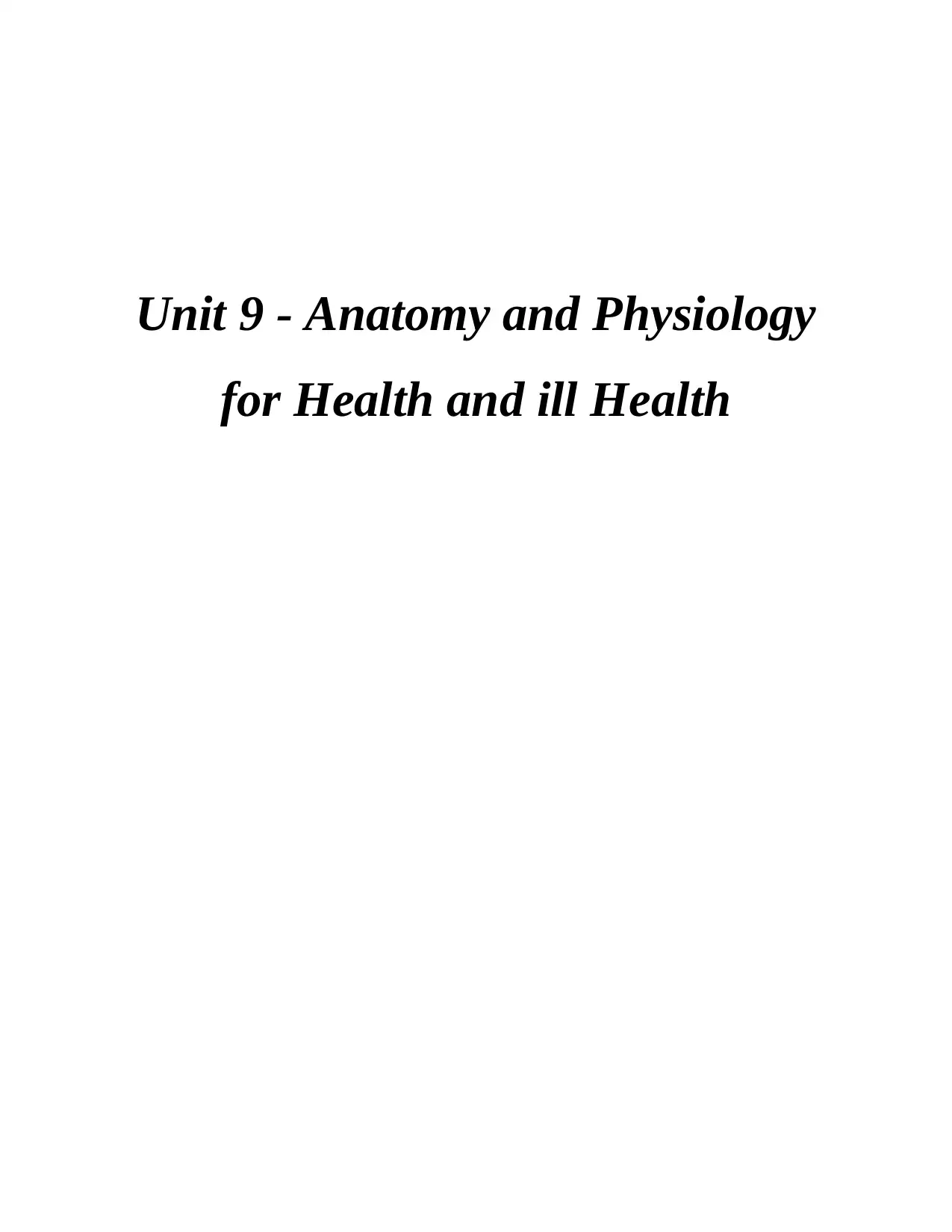
Unit 9 - Anatomy and Physiology
for Health and ill Health
for Health and ill Health
Secure Best Marks with AI Grader
Need help grading? Try our AI Grader for instant feedback on your assignments.

Table of Contents
INTRODUCTION...........................................................................................................................1
TAKS 1............................................................................................................................................1
P1. Functions of a human body cell and its role during osmosis and diffusion.....................1
P2. Describe the structure and function of different body systems in the healthy human body. 3
M1. Compare differences in the healthy human body with individuals who have ill-health.5
TASK 2............................................................................................................................................5
P3. Explain how body systems co-operate to maintain life and health of the individual.......5
M2. Examine how the cardiovascular, respiratory and digestive system work together to
provide energy for the healthy human body...........................................................................5
D1. Critically evaluate the role of body systems in homeostasis for health and ill-health .. .5
TASK 3............................................................................................................................................5
P4. Interpret normal and abnormal physiological measurements for an individual with ill-
health in own workplace setting.............................................................................................5
M3. Justify actions taken when physiological measurements are outside normal limits.......5
TASK 4............................................................................................................................................5
P5. Prepare a risk assessment which minimises harm to the health of an individual with ill-
health in own workplace setting.............................................................................................5
P6. Produce a person-centred care plan which includes interventions that improve an
individual's ill-health and associated outcomes......................................................................5
M4. Assess the effectiveness of the care plan in communicating the individual's needs and
requirements to others involved in caring for the individual.................................................5
D2. Critically evaluate own care plan and associated records of physiological measurements
for an individual with ill-health to identify areas of good practice and areas for improvement.5
CONCLUSION................................................................................................................................5
REFERENCES................................................................................................................................6
INTRODUCTION...........................................................................................................................1
TAKS 1............................................................................................................................................1
P1. Functions of a human body cell and its role during osmosis and diffusion.....................1
P2. Describe the structure and function of different body systems in the healthy human body. 3
M1. Compare differences in the healthy human body with individuals who have ill-health.5
TASK 2............................................................................................................................................5
P3. Explain how body systems co-operate to maintain life and health of the individual.......5
M2. Examine how the cardiovascular, respiratory and digestive system work together to
provide energy for the healthy human body...........................................................................5
D1. Critically evaluate the role of body systems in homeostasis for health and ill-health .. .5
TASK 3............................................................................................................................................5
P4. Interpret normal and abnormal physiological measurements for an individual with ill-
health in own workplace setting.............................................................................................5
M3. Justify actions taken when physiological measurements are outside normal limits.......5
TASK 4............................................................................................................................................5
P5. Prepare a risk assessment which minimises harm to the health of an individual with ill-
health in own workplace setting.............................................................................................5
P6. Produce a person-centred care plan which includes interventions that improve an
individual's ill-health and associated outcomes......................................................................5
M4. Assess the effectiveness of the care plan in communicating the individual's needs and
requirements to others involved in caring for the individual.................................................5
D2. Critically evaluate own care plan and associated records of physiological measurements
for an individual with ill-health to identify areas of good practice and areas for improvement.5
CONCLUSION................................................................................................................................5
REFERENCES................................................................................................................................6
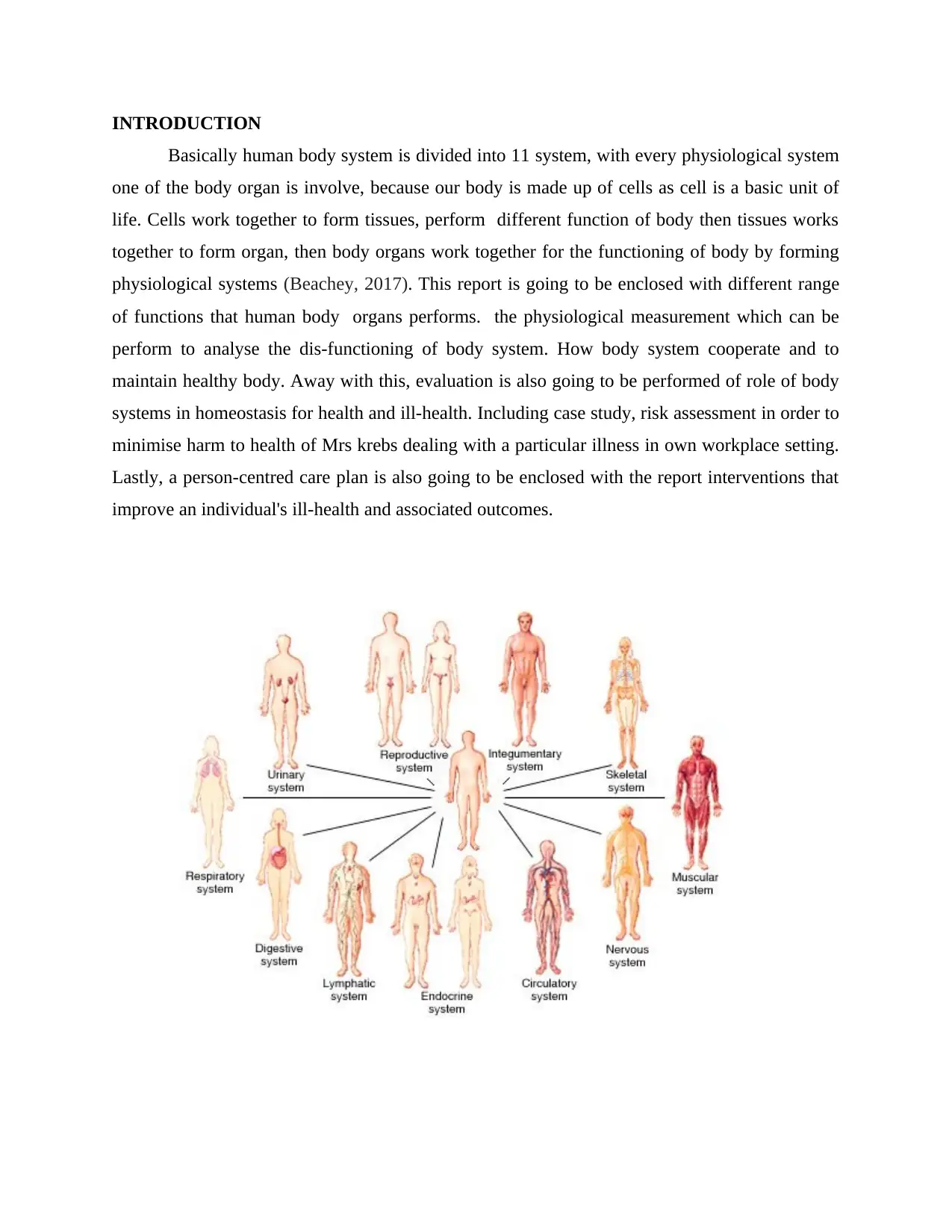
INTRODUCTION
Basically human body system is divided into 11 system, with every physiological system
one of the body organ is involve, because our body is made up of cells as cell is a basic unit of
life. Cells work together to form tissues, perform different function of body then tissues works
together to form organ, then body organs work together for the functioning of body by forming
physiological systems (Beachey, 2017). This report is going to be enclosed with different range
of functions that human body organs performs. the physiological measurement which can be
perform to analyse the dis-functioning of body system. How body system cooperate and to
maintain healthy body. Away with this, evaluation is also going to be performed of role of body
systems in homeostasis for health and ill-health. Including case study, risk assessment in order to
minimise harm to health of Mrs krebs dealing with a particular illness in own workplace setting.
Lastly, a person-centred care plan is also going to be enclosed with the report interventions that
improve an individual's ill-health and associated outcomes.
Basically human body system is divided into 11 system, with every physiological system
one of the body organ is involve, because our body is made up of cells as cell is a basic unit of
life. Cells work together to form tissues, perform different function of body then tissues works
together to form organ, then body organs work together for the functioning of body by forming
physiological systems (Beachey, 2017). This report is going to be enclosed with different range
of functions that human body organs performs. the physiological measurement which can be
perform to analyse the dis-functioning of body system. How body system cooperate and to
maintain healthy body. Away with this, evaluation is also going to be performed of role of body
systems in homeostasis for health and ill-health. Including case study, risk assessment in order to
minimise harm to health of Mrs krebs dealing with a particular illness in own workplace setting.
Lastly, a person-centred care plan is also going to be enclosed with the report interventions that
improve an individual's ill-health and associated outcomes.

TAKS 1
P1 : Function of human body cell and its role during osmosis and diffusion
Function of human body cell :
Cell: Cell is a basic unit of life, actually our body if made up of cells, every living organisms and
living things are made of cell, it provide structural to the body. Cells group together to form
tissues and than tissues groups together to form organ, such as lung, heart, brain. Cells of our
body works for the nutrients uptake from food so that in further biochemical functions will carry
out by using nutrient (Clancy and McVicar, 2017).
Cell contain a number of functional structures called organelles ( cell membrane, nucleus
(DNA), mitochondria, cytoplasm, endoplasmic reticulum, ribosome's, golgi apparatus,
lysosomes) and these organelles carry out tasks such as making protein , processing biochemical
reactions in our body, and in our body there are different kinds of biochemical reaction occurs
for fulfilling the different needs of body e.g. for generating energy (ATP), DNA replication,
metabolism, transportation and secretion of substances (Clancy and McVicar, 2017).
Functions
P1 : Function of human body cell and its role during osmosis and diffusion
Function of human body cell :
Cell: Cell is a basic unit of life, actually our body if made up of cells, every living organisms and
living things are made of cell, it provide structural to the body. Cells group together to form
tissues and than tissues groups together to form organ, such as lung, heart, brain. Cells of our
body works for the nutrients uptake from food so that in further biochemical functions will carry
out by using nutrient (Clancy and McVicar, 2017).
Cell contain a number of functional structures called organelles ( cell membrane, nucleus
(DNA), mitochondria, cytoplasm, endoplasmic reticulum, ribosome's, golgi apparatus,
lysosomes) and these organelles carry out tasks such as making protein , processing biochemical
reactions in our body, and in our body there are different kinds of biochemical reaction occurs
for fulfilling the different needs of body e.g. for generating energy (ATP), DNA replication,
metabolism, transportation and secretion of substances (Clancy and McVicar, 2017).
Functions
Secure Best Marks with AI Grader
Need help grading? Try our AI Grader for instant feedback on your assignments.
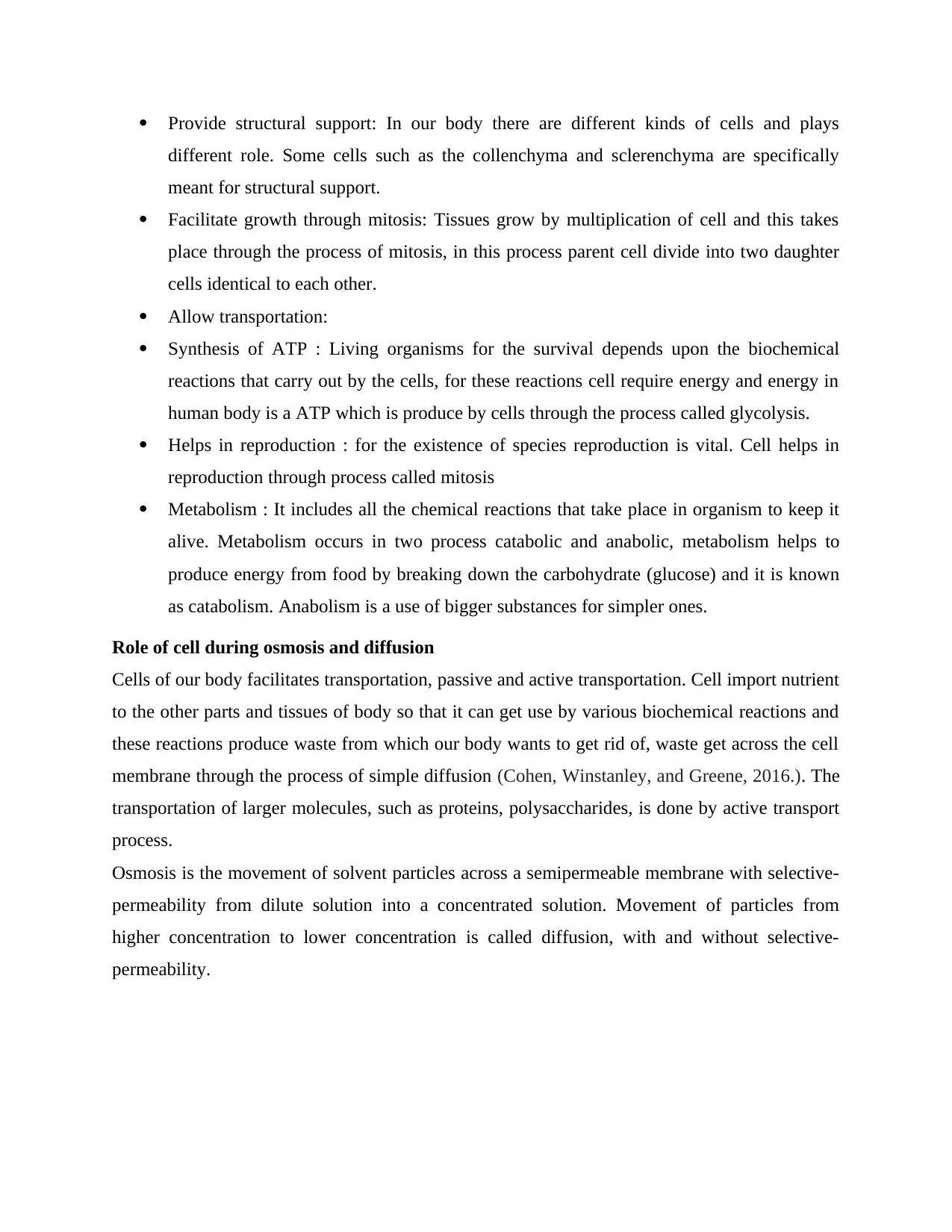
Provide structural support: In our body there are different kinds of cells and plays
different role. Some cells such as the collenchyma and sclerenchyma are specifically
meant for structural support.
Facilitate growth through mitosis: Tissues grow by multiplication of cell and this takes
place through the process of mitosis, in this process parent cell divide into two daughter
cells identical to each other.
Allow transportation:
Synthesis of ATP : Living organisms for the survival depends upon the biochemical
reactions that carry out by the cells, for these reactions cell require energy and energy in
human body is a ATP which is produce by cells through the process called glycolysis.
Helps in reproduction : for the existence of species reproduction is vital. Cell helps in
reproduction through process called mitosis
Metabolism : It includes all the chemical reactions that take place in organism to keep it
alive. Metabolism occurs in two process catabolic and anabolic, metabolism helps to
produce energy from food by breaking down the carbohydrate (glucose) and it is known
as catabolism. Anabolism is a use of bigger substances for simpler ones.
Role of cell during osmosis and diffusion
Cells of our body facilitates transportation, passive and active transportation. Cell import nutrient
to the other parts and tissues of body so that it can get use by various biochemical reactions and
these reactions produce waste from which our body wants to get rid of, waste get across the cell
membrane through the process of simple diffusion (Cohen, Winstanley, and Greene, 2016.). The
transportation of larger molecules, such as proteins, polysaccharides, is done by active transport
process.
Osmosis is the movement of solvent particles across a semipermeable membrane with selective-
permeability from dilute solution into a concentrated solution. Movement of particles from
higher concentration to lower concentration is called diffusion, with and without selective-
permeability.
different role. Some cells such as the collenchyma and sclerenchyma are specifically
meant for structural support.
Facilitate growth through mitosis: Tissues grow by multiplication of cell and this takes
place through the process of mitosis, in this process parent cell divide into two daughter
cells identical to each other.
Allow transportation:
Synthesis of ATP : Living organisms for the survival depends upon the biochemical
reactions that carry out by the cells, for these reactions cell require energy and energy in
human body is a ATP which is produce by cells through the process called glycolysis.
Helps in reproduction : for the existence of species reproduction is vital. Cell helps in
reproduction through process called mitosis
Metabolism : It includes all the chemical reactions that take place in organism to keep it
alive. Metabolism occurs in two process catabolic and anabolic, metabolism helps to
produce energy from food by breaking down the carbohydrate (glucose) and it is known
as catabolism. Anabolism is a use of bigger substances for simpler ones.
Role of cell during osmosis and diffusion
Cells of our body facilitates transportation, passive and active transportation. Cell import nutrient
to the other parts and tissues of body so that it can get use by various biochemical reactions and
these reactions produce waste from which our body wants to get rid of, waste get across the cell
membrane through the process of simple diffusion (Cohen, Winstanley, and Greene, 2016.). The
transportation of larger molecules, such as proteins, polysaccharides, is done by active transport
process.
Osmosis is the movement of solvent particles across a semipermeable membrane with selective-
permeability from dilute solution into a concentrated solution. Movement of particles from
higher concentration to lower concentration is called diffusion, with and without selective-
permeability.
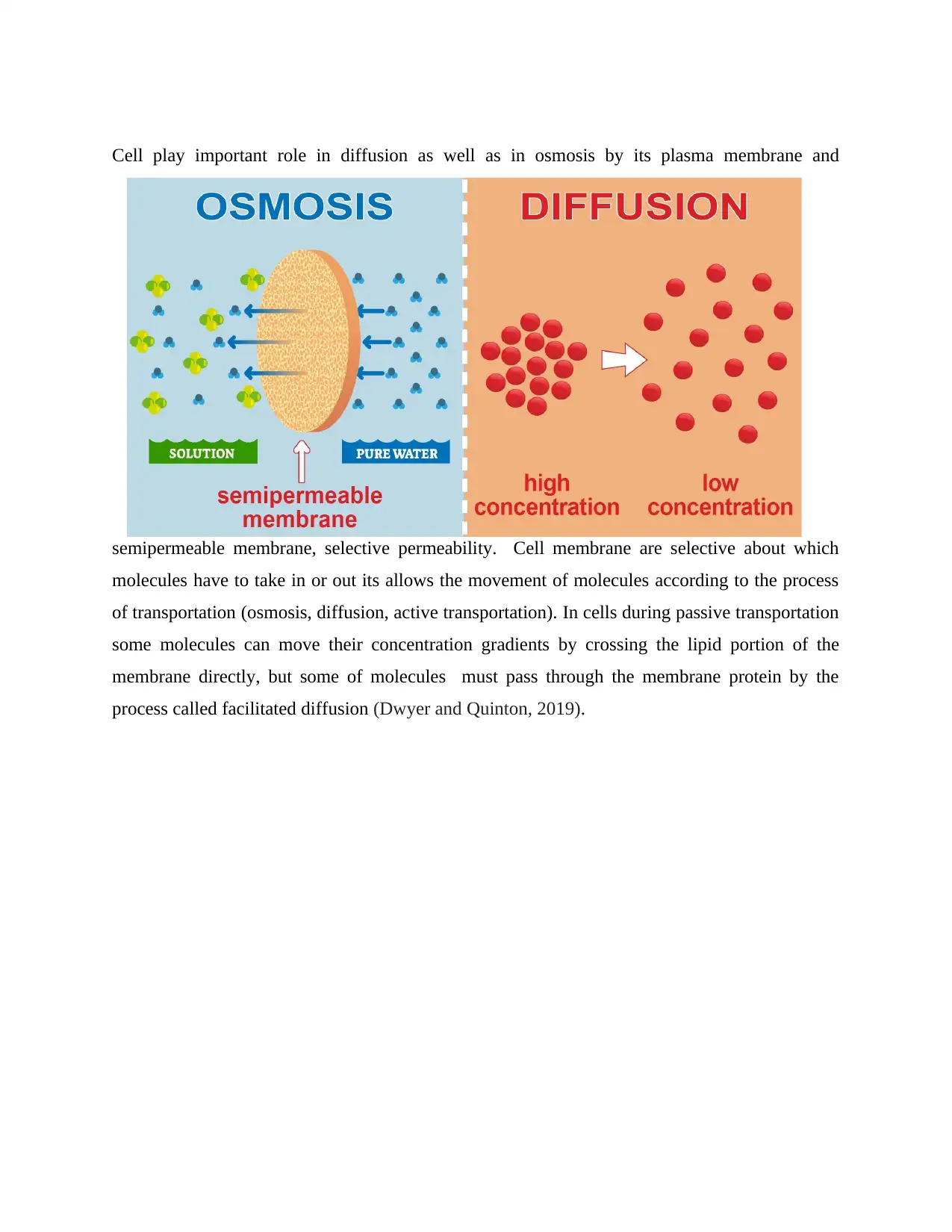
Cell play important role in diffusion as well as in osmosis by its plasma membrane and
semipermeable membrane, selective permeability. Cell membrane are selective about which
molecules have to take in or out its allows the movement of molecules according to the process
of transportation (osmosis, diffusion, active transportation). In cells during passive transportation
some molecules can move their concentration gradients by crossing the lipid portion of the
membrane directly, but some of molecules must pass through the membrane protein by the
process called facilitated diffusion (Dwyer and Quinton, 2019).
semipermeable membrane, selective permeability. Cell membrane are selective about which
molecules have to take in or out its allows the movement of molecules according to the process
of transportation (osmosis, diffusion, active transportation). In cells during passive transportation
some molecules can move their concentration gradients by crossing the lipid portion of the
membrane directly, but some of molecules must pass through the membrane protein by the
process called facilitated diffusion (Dwyer and Quinton, 2019).
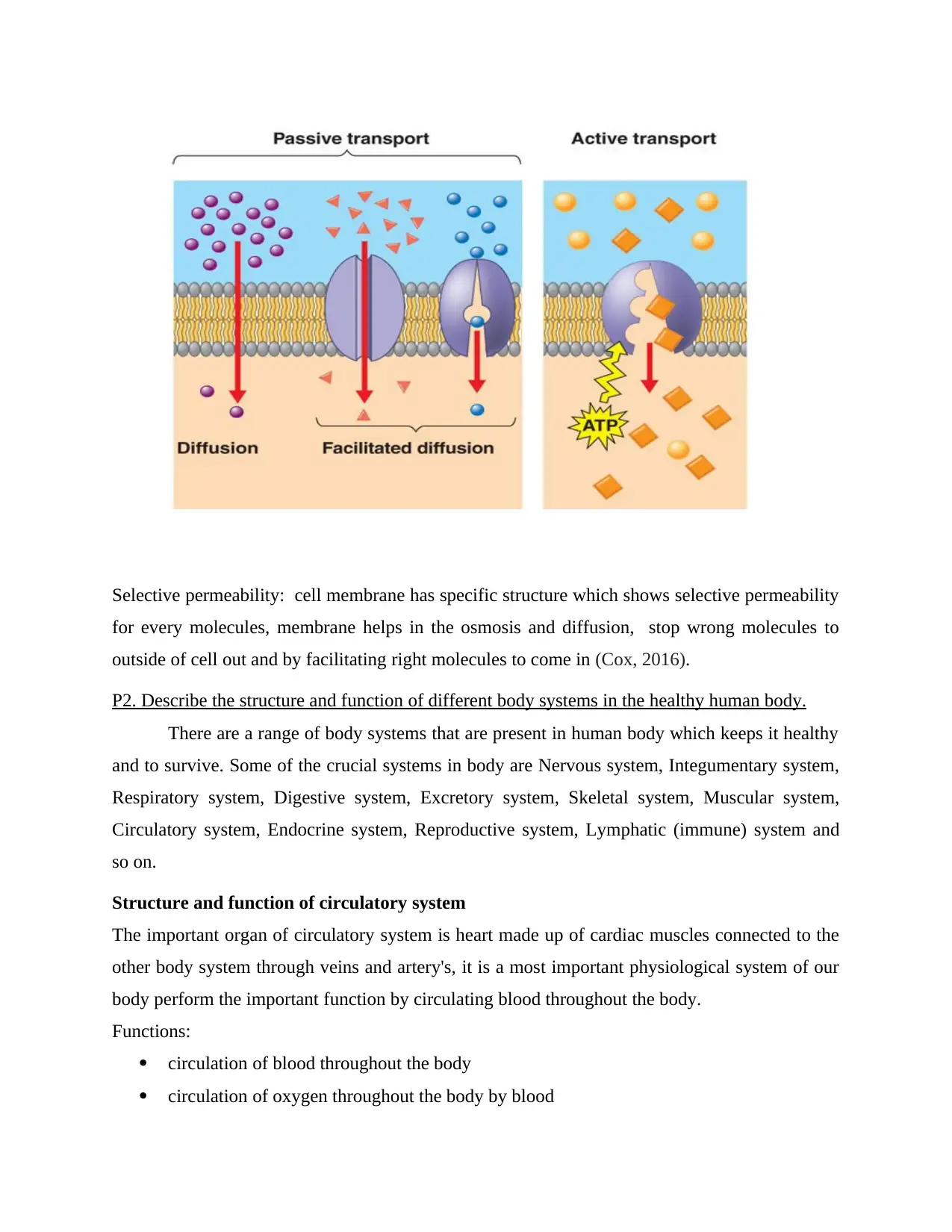
Selective permeability: cell membrane has specific structure which shows selective permeability
for every molecules, membrane helps in the osmosis and diffusion, stop wrong molecules to
outside of cell out and by facilitating right molecules to come in (Cox, 2016).
P2. Describe the structure and function of different body systems in the healthy human body.
There are a range of body systems that are present in human body which keeps it healthy
and to survive. Some of the crucial systems in body are Nervous system, Integumentary system,
Respiratory system, Digestive system, Excretory system, Skeletal system, Muscular system,
Circulatory system, Endocrine system, Reproductive system, Lymphatic (immune) system and
so on.
Structure and function of circulatory system
The important organ of circulatory system is heart made up of cardiac muscles connected to the
other body system through veins and artery's, it is a most important physiological system of our
body perform the important function by circulating blood throughout the body.
Functions:
circulation of blood throughout the body
circulation of oxygen throughout the body by blood
for every molecules, membrane helps in the osmosis and diffusion, stop wrong molecules to
outside of cell out and by facilitating right molecules to come in (Cox, 2016).
P2. Describe the structure and function of different body systems in the healthy human body.
There are a range of body systems that are present in human body which keeps it healthy
and to survive. Some of the crucial systems in body are Nervous system, Integumentary system,
Respiratory system, Digestive system, Excretory system, Skeletal system, Muscular system,
Circulatory system, Endocrine system, Reproductive system, Lymphatic (immune) system and
so on.
Structure and function of circulatory system
The important organ of circulatory system is heart made up of cardiac muscles connected to the
other body system through veins and artery's, it is a most important physiological system of our
body perform the important function by circulating blood throughout the body.
Functions:
circulation of blood throughout the body
circulation of oxygen throughout the body by blood
Paraphrase This Document
Need a fresh take? Get an instant paraphrase of this document with our AI Paraphraser
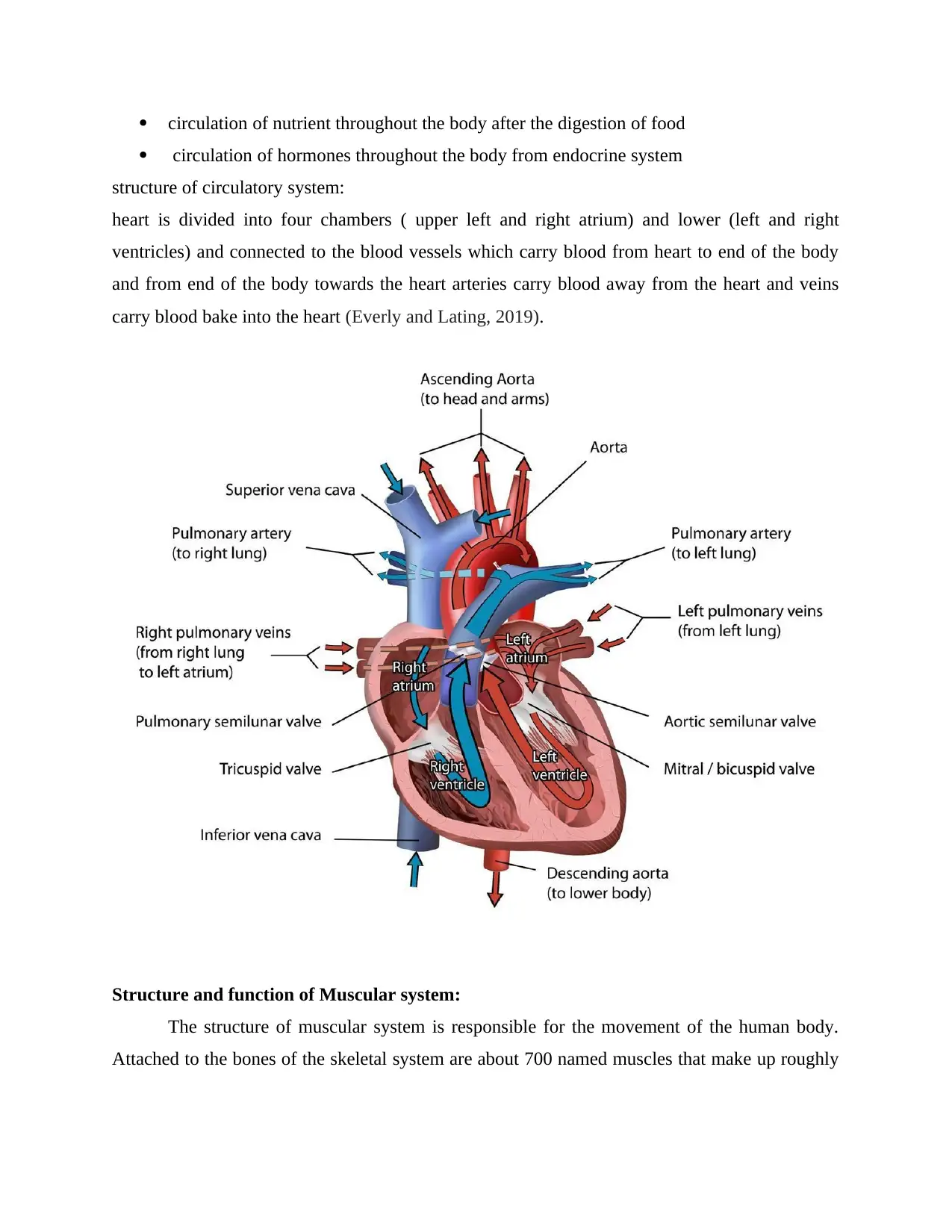
circulation of nutrient throughout the body after the digestion of food
circulation of hormones throughout the body from endocrine system
structure of circulatory system:
heart is divided into four chambers ( upper left and right atrium) and lower (left and right
ventricles) and connected to the blood vessels which carry blood from heart to end of the body
and from end of the body towards the heart arteries carry blood away from the heart and veins
carry blood bake into the heart (Everly and Lating, 2019).
Structure and function of Muscular system:
The structure of muscular system is responsible for the movement of the human body.
Attached to the bones of the skeletal system are about 700 named muscles that make up roughly
circulation of hormones throughout the body from endocrine system
structure of circulatory system:
heart is divided into four chambers ( upper left and right atrium) and lower (left and right
ventricles) and connected to the blood vessels which carry blood from heart to end of the body
and from end of the body towards the heart arteries carry blood away from the heart and veins
carry blood bake into the heart (Everly and Lating, 2019).
Structure and function of Muscular system:
The structure of muscular system is responsible for the movement of the human body.
Attached to the bones of the skeletal system are about 700 named muscles that make up roughly
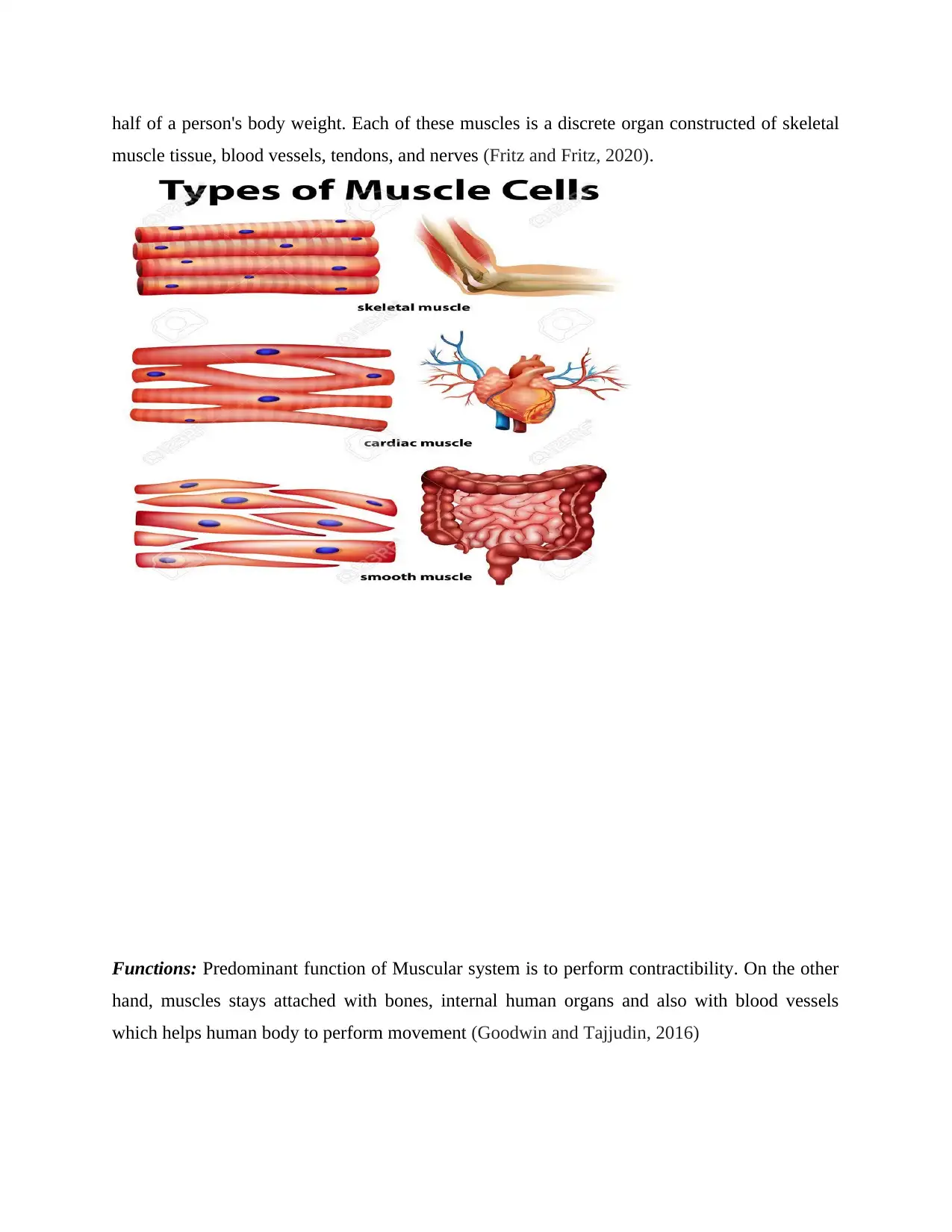
half of a person's body weight. Each of these muscles is a discrete organ constructed of skeletal
muscle tissue, blood vessels, tendons, and nerves (Fritz and Fritz, 2020).
Functions: Predominant function of Muscular system is to perform contractibility. On the other
hand, muscles stays attached with bones, internal human organs and also with blood vessels
which helps human body to perform movement (Goodwin and Tajjudin, 2016)
muscle tissue, blood vessels, tendons, and nerves (Fritz and Fritz, 2020).
Functions: Predominant function of Muscular system is to perform contractibility. On the other
hand, muscles stays attached with bones, internal human organs and also with blood vessels
which helps human body to perform movement (Goodwin and Tajjudin, 2016)
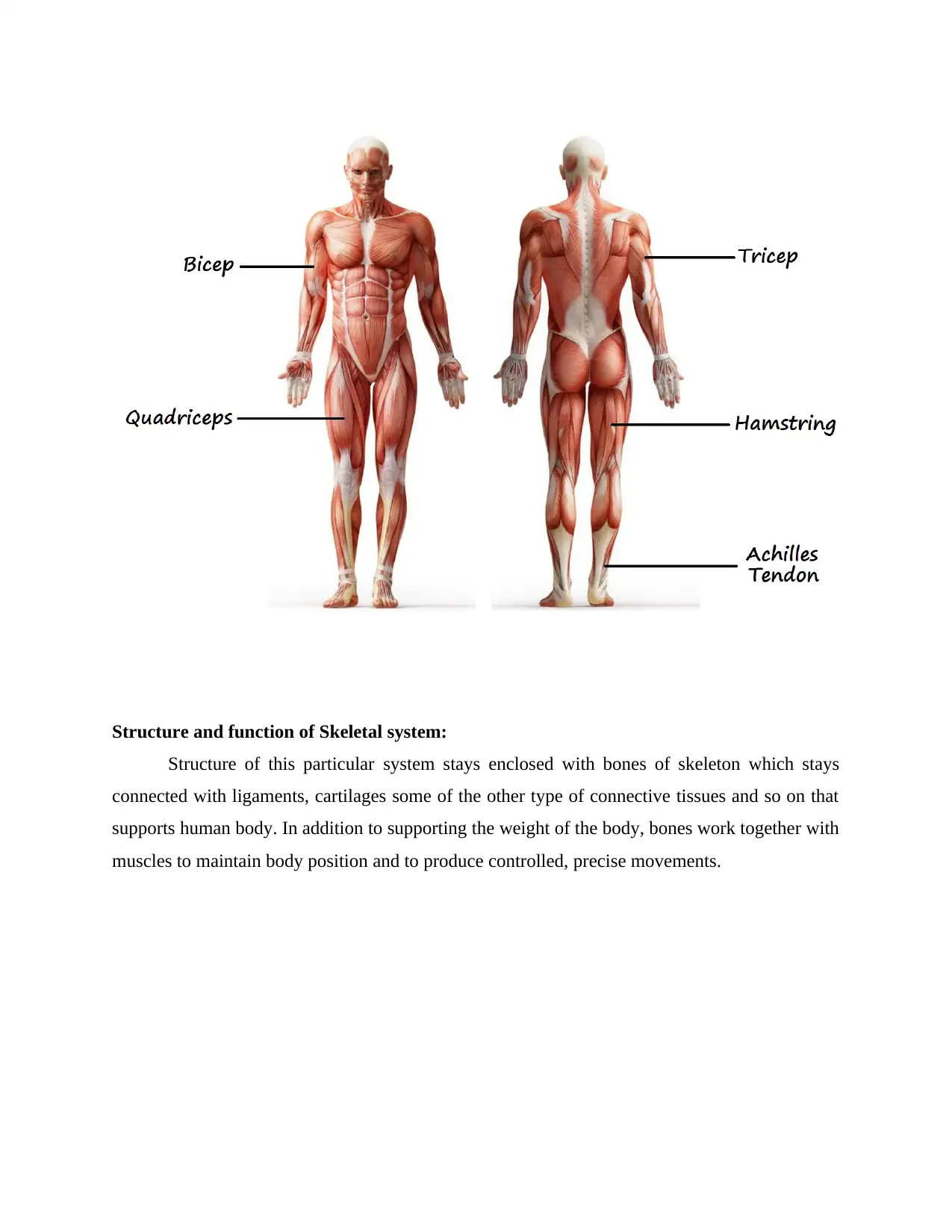
Structure and function of Skeletal system:
Structure of this particular system stays enclosed with bones of skeleton which stays
connected with ligaments, cartilages some of the other type of connective tissues and so on that
supports human body. In addition to supporting the weight of the body, bones work together with
muscles to maintain body position and to produce controlled, precise movements.
Structure of this particular system stays enclosed with bones of skeleton which stays
connected with ligaments, cartilages some of the other type of connective tissues and so on that
supports human body. In addition to supporting the weight of the body, bones work together with
muscles to maintain body position and to produce controlled, precise movements.
Secure Best Marks with AI Grader
Need help grading? Try our AI Grader for instant feedback on your assignments.
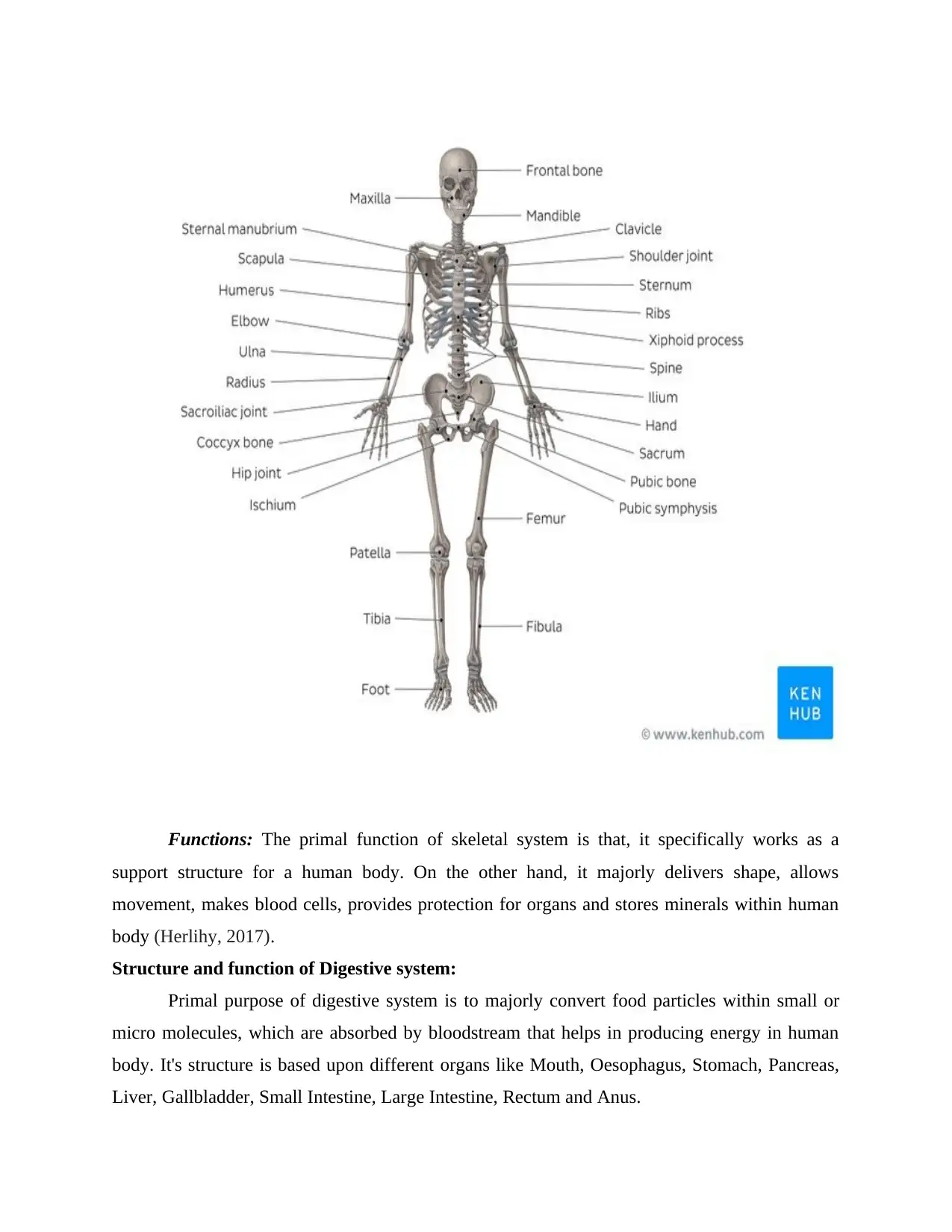
Functions: The primal function of skeletal system is that, it specifically works as a
support structure for a human body. On the other hand, it majorly delivers shape, allows
movement, makes blood cells, provides protection for organs and stores minerals within human
body (Herlihy, 2017).
Structure and function of Digestive system:
Primal purpose of digestive system is to majorly convert food particles within small or
micro molecules, which are absorbed by bloodstream that helps in producing energy in human
body. It's structure is based upon different organs like Mouth, Oesophagus, Stomach, Pancreas,
Liver, Gallbladder, Small Intestine, Large Intestine, Rectum and Anus.
support structure for a human body. On the other hand, it majorly delivers shape, allows
movement, makes blood cells, provides protection for organs and stores minerals within human
body (Herlihy, 2017).
Structure and function of Digestive system:
Primal purpose of digestive system is to majorly convert food particles within small or
micro molecules, which are absorbed by bloodstream that helps in producing energy in human
body. It's structure is based upon different organs like Mouth, Oesophagus, Stomach, Pancreas,
Liver, Gallbladder, Small Intestine, Large Intestine, Rectum and Anus.
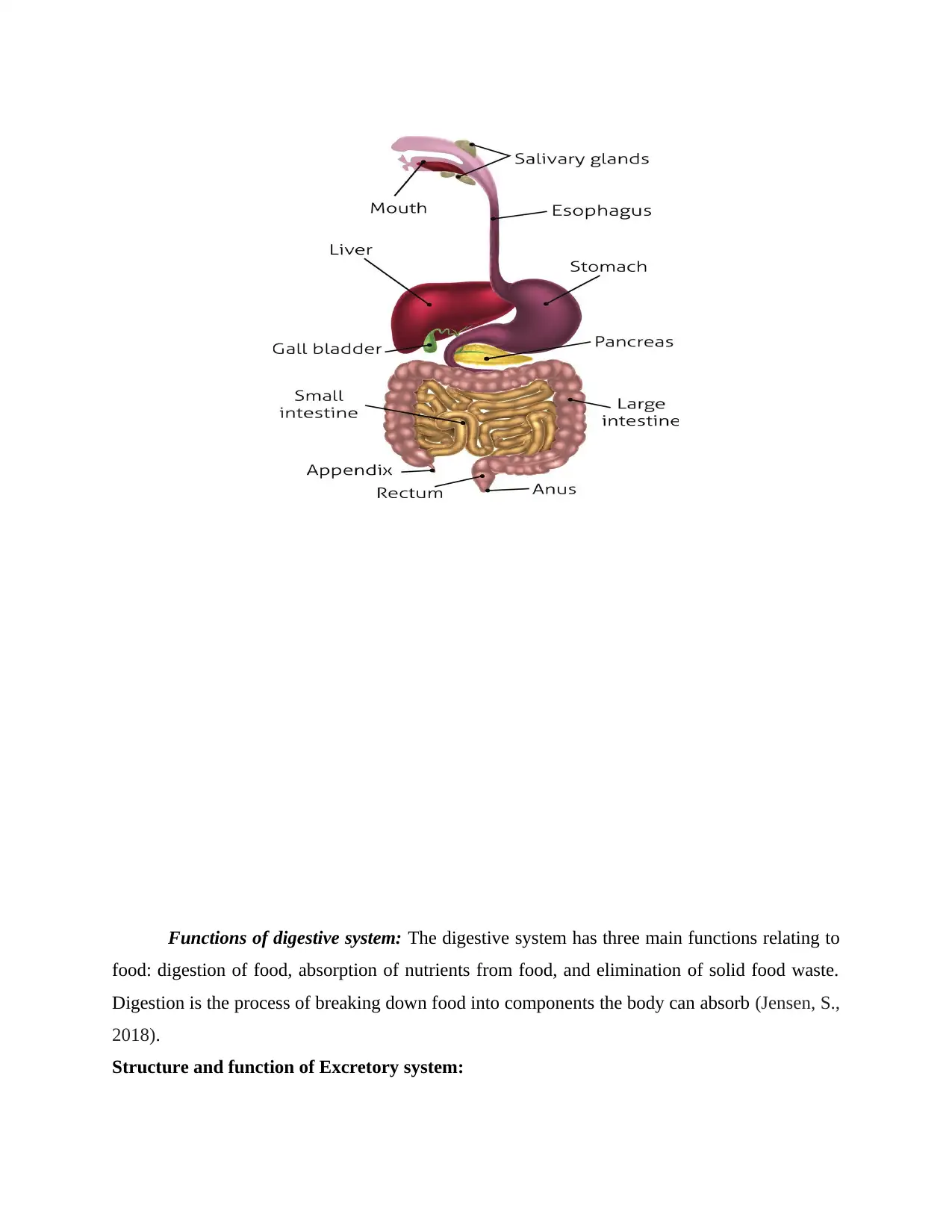
Functions of digestive system: The digestive system has three main functions relating to
food: digestion of food, absorption of nutrients from food, and elimination of solid food waste.
Digestion is the process of breaking down food into components the body can absorb (Jensen, S.,
2018).
Structure and function of Excretory system:
food: digestion of food, absorption of nutrients from food, and elimination of solid food waste.
Digestion is the process of breaking down food into components the body can absorb (Jensen, S.,
2018).
Structure and function of Excretory system:
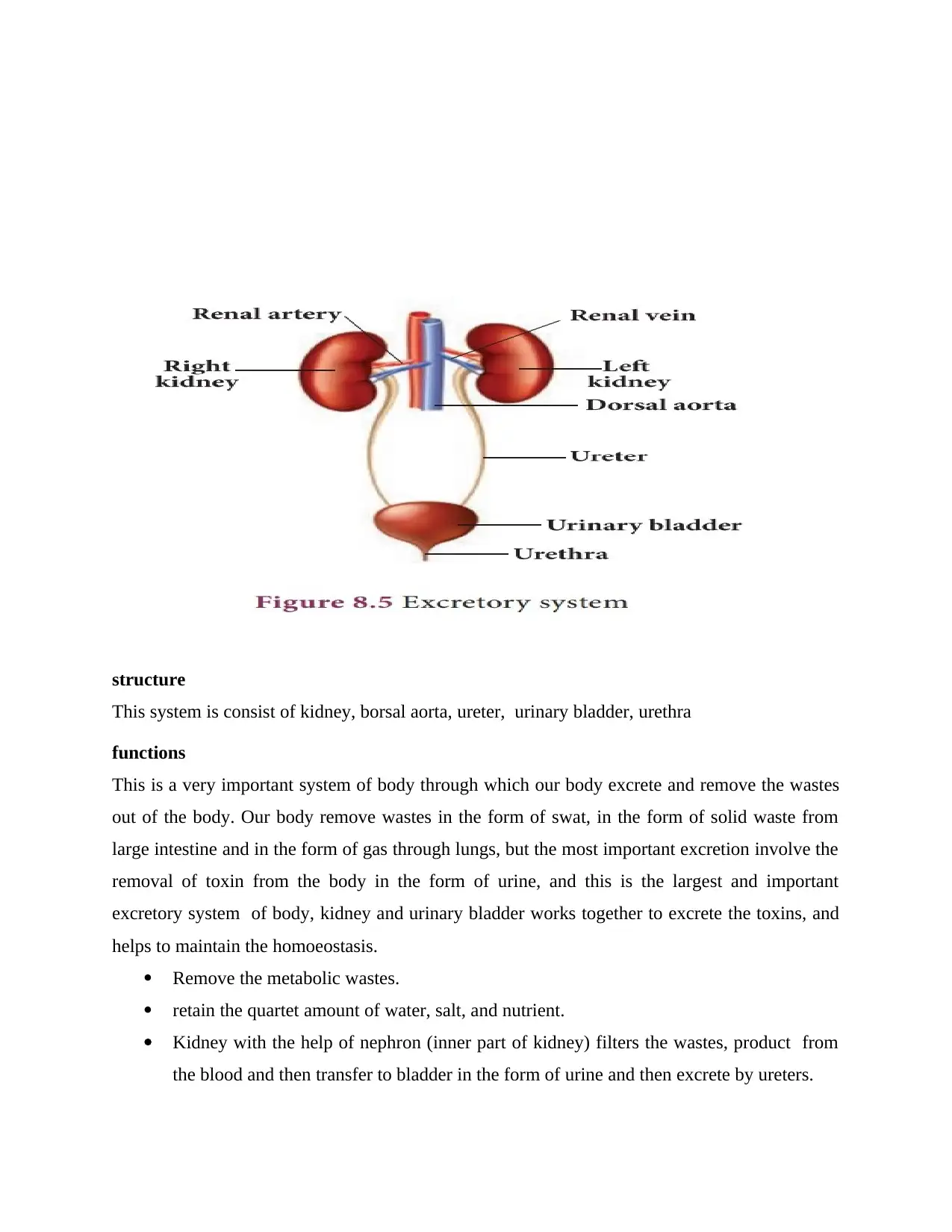
structure
This system is consist of kidney, borsal aorta, ureter, urinary bladder, urethra
functions
This is a very important system of body through which our body excrete and remove the wastes
out of the body. Our body remove wastes in the form of swat, in the form of solid waste from
large intestine and in the form of gas through lungs, but the most important excretion involve the
removal of toxin from the body in the form of urine, and this is the largest and important
excretory system of body, kidney and urinary bladder works together to excrete the toxins, and
helps to maintain the homoeostasis.
Remove the metabolic wastes.
retain the quartet amount of water, salt, and nutrient.
Kidney with the help of nephron (inner part of kidney) filters the wastes, product from
the blood and then transfer to bladder in the form of urine and then excrete by ureters.
This system is consist of kidney, borsal aorta, ureter, urinary bladder, urethra
functions
This is a very important system of body through which our body excrete and remove the wastes
out of the body. Our body remove wastes in the form of swat, in the form of solid waste from
large intestine and in the form of gas through lungs, but the most important excretion involve the
removal of toxin from the body in the form of urine, and this is the largest and important
excretory system of body, kidney and urinary bladder works together to excrete the toxins, and
helps to maintain the homoeostasis.
Remove the metabolic wastes.
retain the quartet amount of water, salt, and nutrient.
Kidney with the help of nephron (inner part of kidney) filters the wastes, product from
the blood and then transfer to bladder in the form of urine and then excrete by ureters.
Paraphrase This Document
Need a fresh take? Get an instant paraphrase of this document with our AI Paraphraser
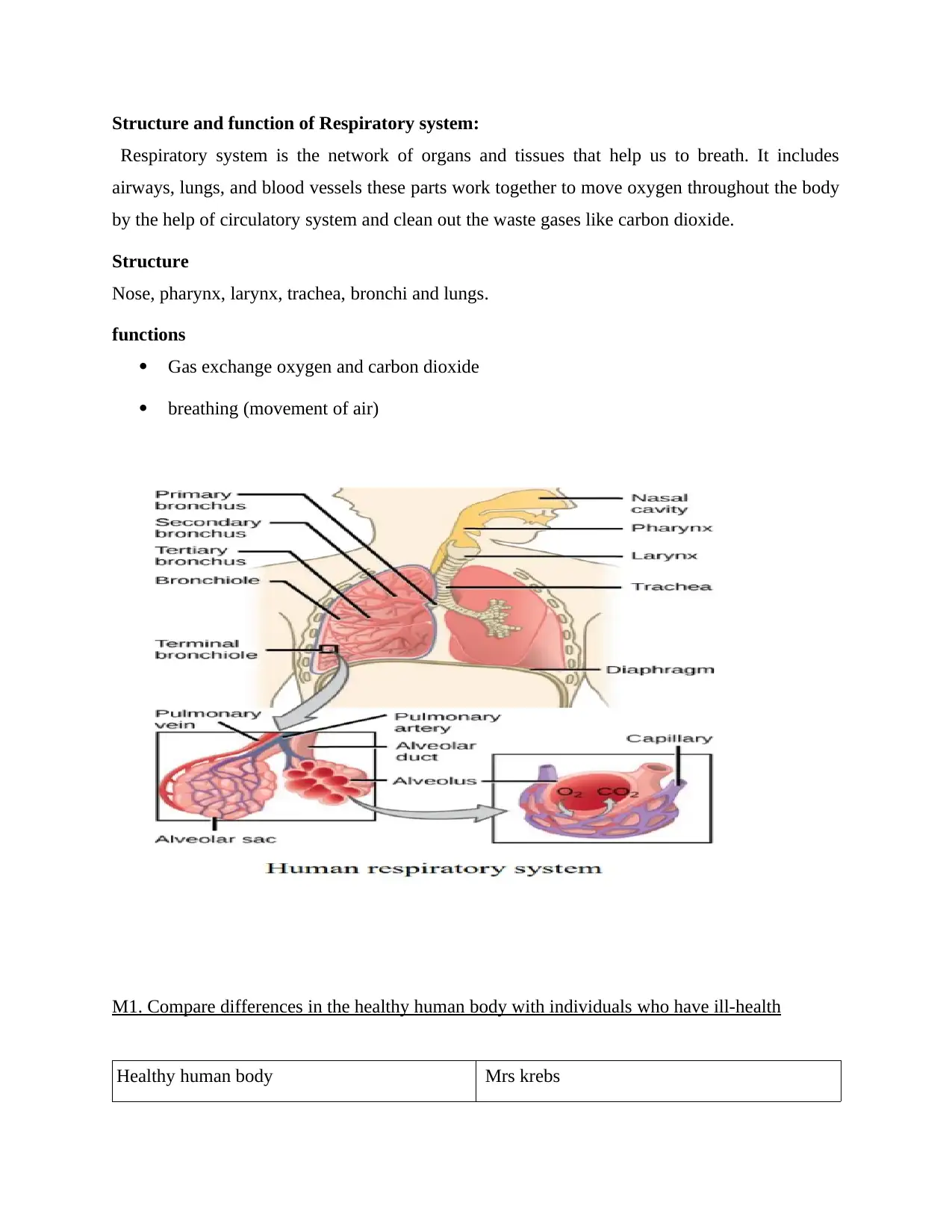
Structure and function of Respiratory system:
Respiratory system is the network of organs and tissues that help us to breath. It includes
airways, lungs, and blood vessels these parts work together to move oxygen throughout the body
by the help of circulatory system and clean out the waste gases like carbon dioxide.
Structure
Nose, pharynx, larynx, trachea, bronchi and lungs.
functions
Gas exchange oxygen and carbon dioxide
breathing (movement of air)
M1. Compare differences in the healthy human body with individuals who have ill-health
Healthy human body Mrs krebs
Respiratory system is the network of organs and tissues that help us to breath. It includes
airways, lungs, and blood vessels these parts work together to move oxygen throughout the body
by the help of circulatory system and clean out the waste gases like carbon dioxide.
Structure
Nose, pharynx, larynx, trachea, bronchi and lungs.
functions
Gas exchange oxygen and carbon dioxide
breathing (movement of air)
M1. Compare differences in the healthy human body with individuals who have ill-health
Healthy human body Mrs krebs

Mentally active
healthy Daly routine
healthy diet
emotionally strong
physically strong
stress free mind
strong immune system
normal functioning of adrenal gland
normal heart functioning
Mentally inactive
the person who do not perform the
healthy Daly routine
ill-health can also be happen due to
unhealthy diet
the person with stress and hypertension
get emotionally weaker
by having improper diet and Daly
routine, with the work and family stress
get physically weaker it involves
hypertension, improper digitation,
breathing problems etc.
stress is the symptoms of unhealthy
body , it can cause various health issues
weak immune system is symptom of
unhealthy human body because the
person with weak immune system cant
resist the pathogens.
Dis functioning of adrenal gland
abnormal heart functioning
Healthy body doesn't mean disease free body, healthy means physically, mentally, emotionally,
as well as immunologically strong, so the healthy person is that who posses all these qualities
and the unhealthy person is that who posses weaknesses on some of that qualities.
healthy Daly routine
healthy diet
emotionally strong
physically strong
stress free mind
strong immune system
normal functioning of adrenal gland
normal heart functioning
Mentally inactive
the person who do not perform the
healthy Daly routine
ill-health can also be happen due to
unhealthy diet
the person with stress and hypertension
get emotionally weaker
by having improper diet and Daly
routine, with the work and family stress
get physically weaker it involves
hypertension, improper digitation,
breathing problems etc.
stress is the symptoms of unhealthy
body , it can cause various health issues
weak immune system is symptom of
unhealthy human body because the
person with weak immune system cant
resist the pathogens.
Dis functioning of adrenal gland
abnormal heart functioning
Healthy body doesn't mean disease free body, healthy means physically, mentally, emotionally,
as well as immunologically strong, so the healthy person is that who posses all these qualities
and the unhealthy person is that who posses weaknesses on some of that qualities.

TASK 2
P3 Explain how body systems co-operate to maintain life and health of the individual.
As it is know that human body breath, eat, drink, walk, sleep, excrete, perform various
activities, senses ( sight, hearing, smell, taste, and touch) and give response on senses.
Humane is able to do his activities just because of the co-operate functioning of organ
system.
Nervous system
This system give command to the other system of body for there co-operate functioning.
P3 Explain how body systems co-operate to maintain life and health of the individual.
As it is know that human body breath, eat, drink, walk, sleep, excrete, perform various
activities, senses ( sight, hearing, smell, taste, and touch) and give response on senses.
Humane is able to do his activities just because of the co-operate functioning of organ
system.
Nervous system
This system give command to the other system of body for there co-operate functioning.
Secure Best Marks with AI Grader
Need help grading? Try our AI Grader for instant feedback on your assignments.
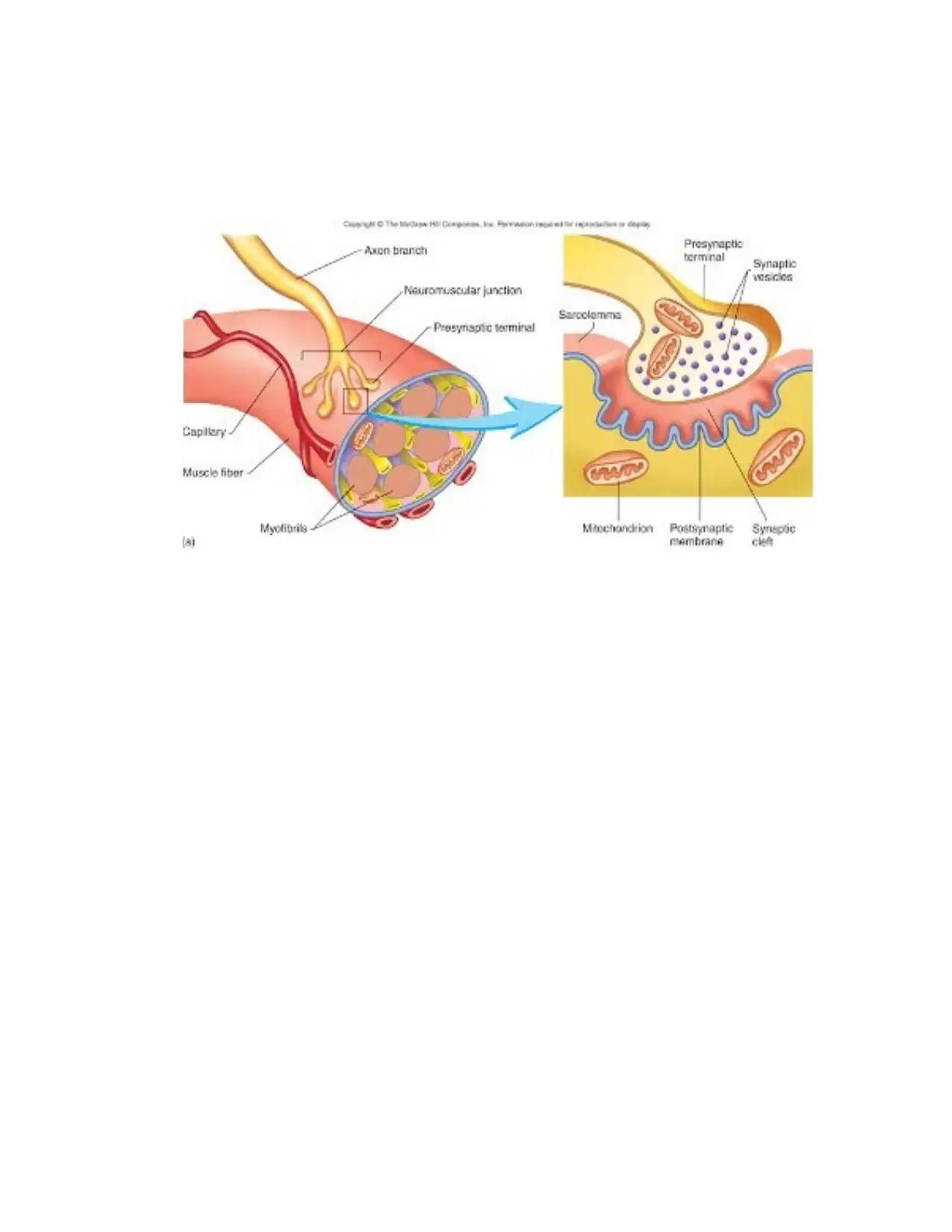
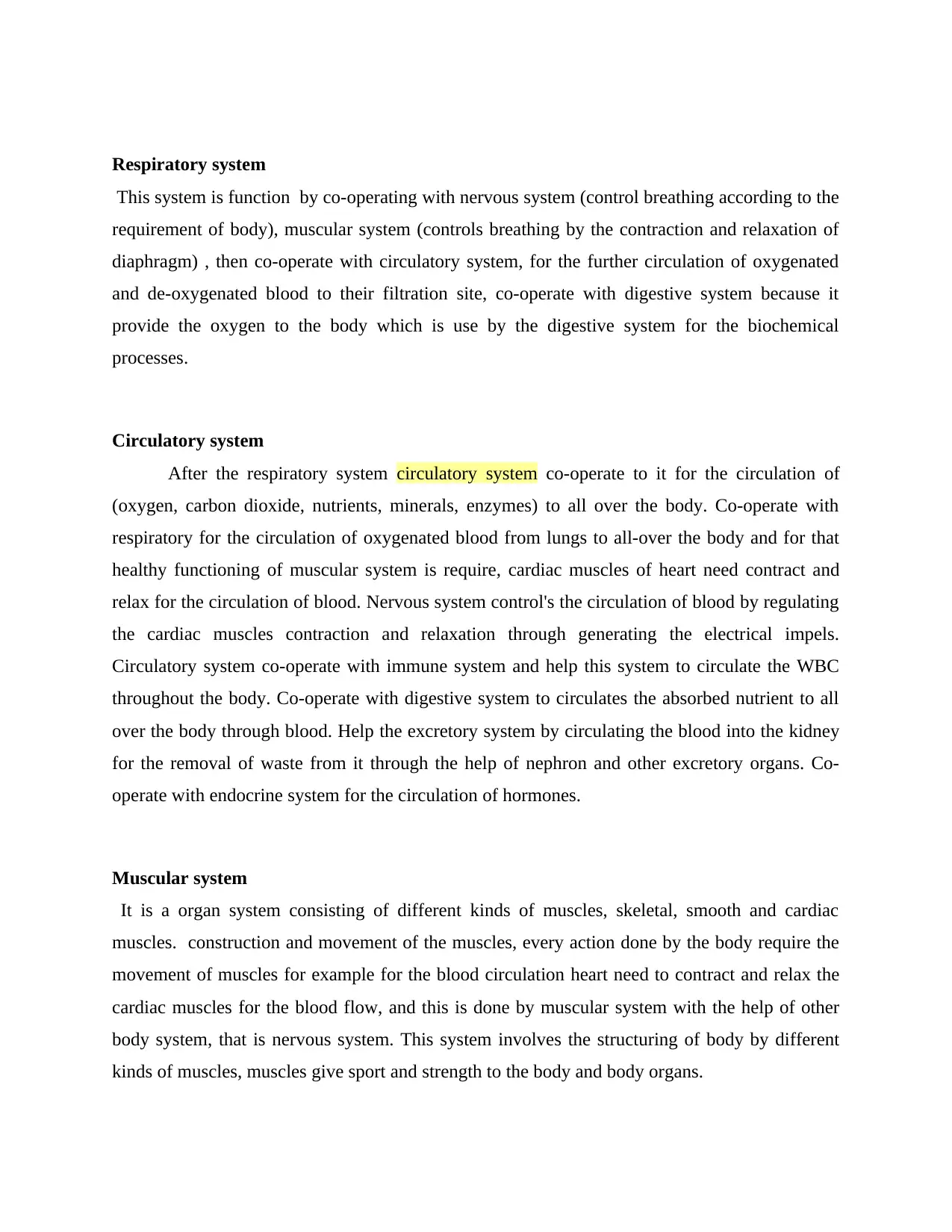
Respiratory system
This system is function by co-operating with nervous system (control breathing according to the
requirement of body), muscular system (controls breathing by the contraction and relaxation of
diaphragm) , then co-operate with circulatory system, for the further circulation of oxygenated
and de-oxygenated blood to their filtration site, co-operate with digestive system because it
provide the oxygen to the body which is use by the digestive system for the biochemical
processes.
Circulatory system
After the respiratory system circulatory system co-operate to it for the circulation of
(oxygen, carbon dioxide, nutrients, minerals, enzymes) to all over the body. Co-operate with
respiratory for the circulation of oxygenated blood from lungs to all-over the body and for that
healthy functioning of muscular system is require, cardiac muscles of heart need contract and
relax for the circulation of blood. Nervous system control's the circulation of blood by regulating
the cardiac muscles contraction and relaxation through generating the electrical impels.
Circulatory system co-operate with immune system and help this system to circulate the WBC
throughout the body. Co-operate with digestive system to circulates the absorbed nutrient to all
over the body through blood. Help the excretory system by circulating the blood into the kidney
for the removal of waste from it through the help of nephron and other excretory organs. Co-
operate with endocrine system for the circulation of hormones.
Muscular system
It is a organ system consisting of different kinds of muscles, skeletal, smooth and cardiac
muscles. construction and movement of the muscles, every action done by the body require the
movement of muscles for example for the blood circulation heart need to contract and relax the
cardiac muscles for the blood flow, and this is done by muscular system with the help of other
body system, that is nervous system. This system involves the structuring of body by different
kinds of muscles, muscles give sport and strength to the body and body organs.
This system is function by co-operating with nervous system (control breathing according to the
requirement of body), muscular system (controls breathing by the contraction and relaxation of
diaphragm) , then co-operate with circulatory system, for the further circulation of oxygenated
and de-oxygenated blood to their filtration site, co-operate with digestive system because it
provide the oxygen to the body which is use by the digestive system for the biochemical
processes.
Circulatory system
After the respiratory system circulatory system co-operate to it for the circulation of
(oxygen, carbon dioxide, nutrients, minerals, enzymes) to all over the body. Co-operate with
respiratory for the circulation of oxygenated blood from lungs to all-over the body and for that
healthy functioning of muscular system is require, cardiac muscles of heart need contract and
relax for the circulation of blood. Nervous system control's the circulation of blood by regulating
the cardiac muscles contraction and relaxation through generating the electrical impels.
Circulatory system co-operate with immune system and help this system to circulate the WBC
throughout the body. Co-operate with digestive system to circulates the absorbed nutrient to all
over the body through blood. Help the excretory system by circulating the blood into the kidney
for the removal of waste from it through the help of nephron and other excretory organs. Co-
operate with endocrine system for the circulation of hormones.
Muscular system
It is a organ system consisting of different kinds of muscles, skeletal, smooth and cardiac
muscles. construction and movement of the muscles, every action done by the body require the
movement of muscles for example for the blood circulation heart need to contract and relax the
cardiac muscles for the blood flow, and this is done by muscular system with the help of other
body system, that is nervous system. This system involves the structuring of body by different
kinds of muscles, muscles give sport and strength to the body and body organs.
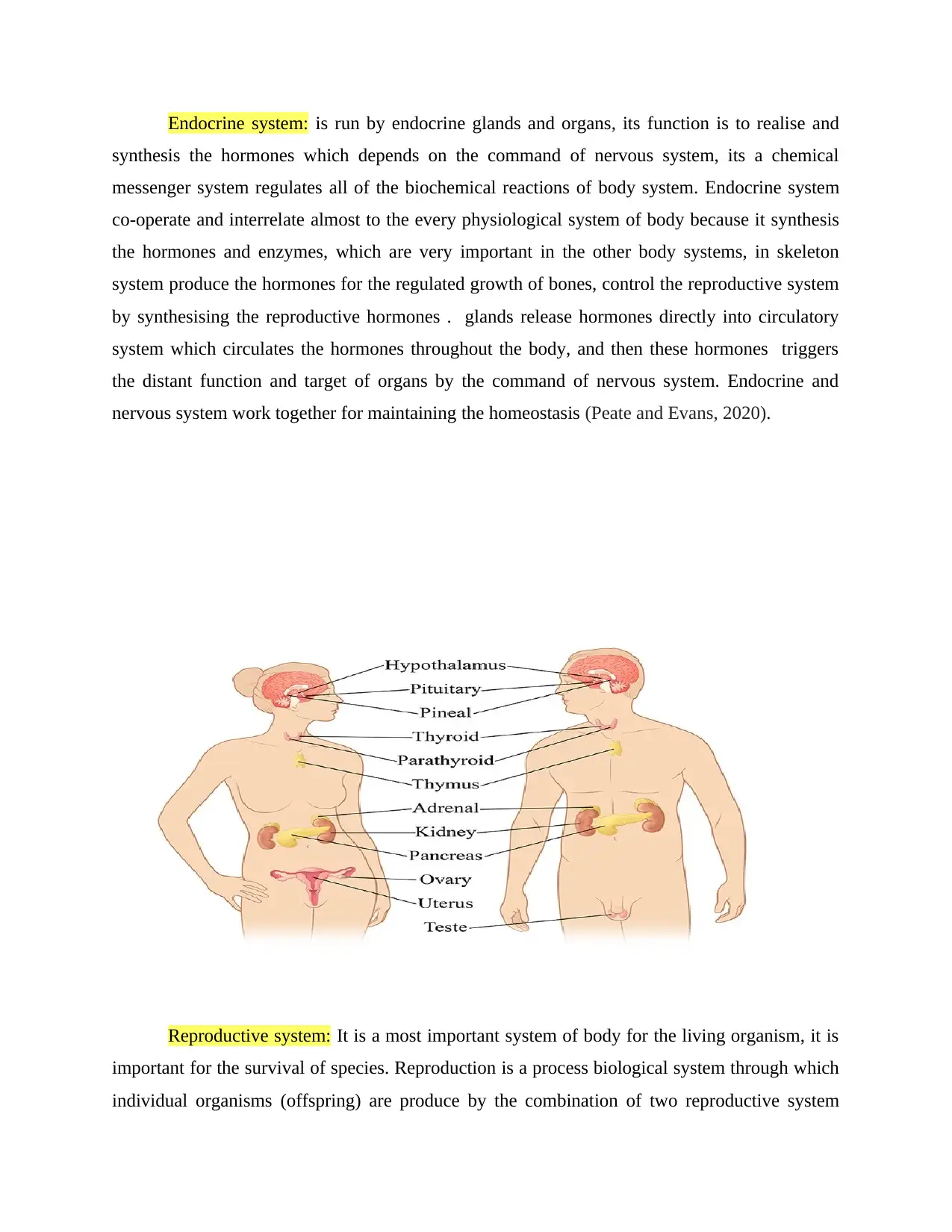
Endocrine system: is run by endocrine glands and organs, its function is to realise and
synthesis the hormones which depends on the command of nervous system, its a chemical
messenger system regulates all of the biochemical reactions of body system. Endocrine system
co-operate and interrelate almost to the every physiological system of body because it synthesis
the hormones and enzymes, which are very important in the other body systems, in skeleton
system produce the hormones for the regulated growth of bones, control the reproductive system
by synthesising the reproductive hormones . glands release hormones directly into circulatory
system which circulates the hormones throughout the body, and then these hormones triggers
the distant function and target of organs by the command of nervous system. Endocrine and
nervous system work together for maintaining the homeostasis (Peate and Evans, 2020).
Reproductive system: It is a most important system of body for the living organism, it is
important for the survival of species. Reproduction is a process biological system through which
individual organisms (offspring) are produce by the combination of two reproductive system
synthesis the hormones which depends on the command of nervous system, its a chemical
messenger system regulates all of the biochemical reactions of body system. Endocrine system
co-operate and interrelate almost to the every physiological system of body because it synthesis
the hormones and enzymes, which are very important in the other body systems, in skeleton
system produce the hormones for the regulated growth of bones, control the reproductive system
by synthesising the reproductive hormones . glands release hormones directly into circulatory
system which circulates the hormones throughout the body, and then these hormones triggers
the distant function and target of organs by the command of nervous system. Endocrine and
nervous system work together for maintaining the homeostasis (Peate and Evans, 2020).
Reproductive system: It is a most important system of body for the living organism, it is
important for the survival of species. Reproduction is a process biological system through which
individual organisms (offspring) are produce by the combination of two reproductive system
Paraphrase This Document
Need a fresh take? Get an instant paraphrase of this document with our AI Paraphraser
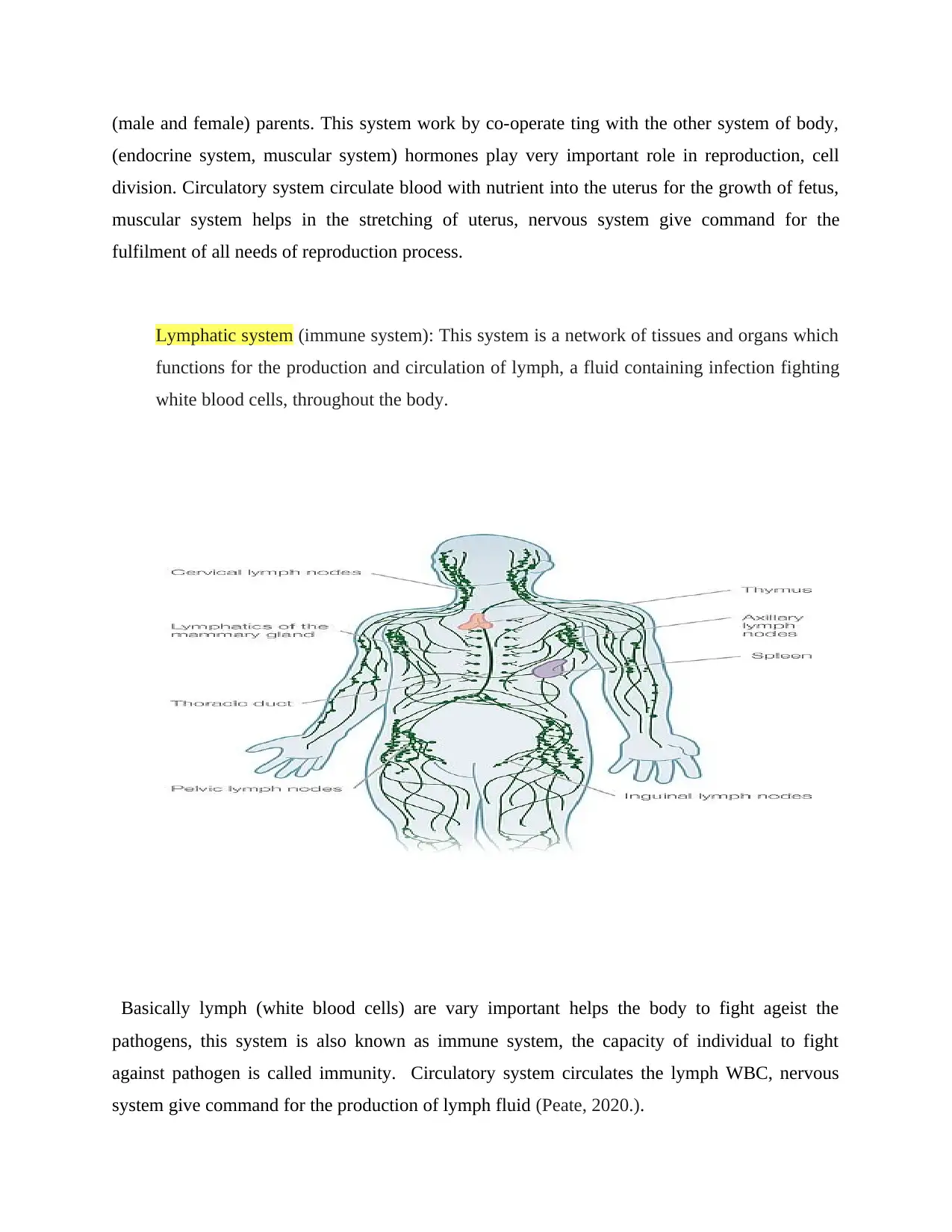
(male and female) parents. This system work by co-operate ting with the other system of body,
(endocrine system, muscular system) hormones play very important role in reproduction, cell
division. Circulatory system circulate blood with nutrient into the uterus for the growth of fetus,
muscular system helps in the stretching of uterus, nervous system give command for the
fulfilment of all needs of reproduction process.
Lymphatic system (immune system): This system is a network of tissues and organs which
functions for the production and circulation of lymph, a fluid containing infection fighting
white blood cells, throughout the body.
Basically lymph (white blood cells) are vary important helps the body to fight ageist the
pathogens, this system is also known as immune system, the capacity of individual to fight
against pathogen is called immunity. Circulatory system circulates the lymph WBC, nervous
system give command for the production of lymph fluid (Peate, 2020.).
(endocrine system, muscular system) hormones play very important role in reproduction, cell
division. Circulatory system circulate blood with nutrient into the uterus for the growth of fetus,
muscular system helps in the stretching of uterus, nervous system give command for the
fulfilment of all needs of reproduction process.
Lymphatic system (immune system): This system is a network of tissues and organs which
functions for the production and circulation of lymph, a fluid containing infection fighting
white blood cells, throughout the body.
Basically lymph (white blood cells) are vary important helps the body to fight ageist the
pathogens, this system is also known as immune system, the capacity of individual to fight
against pathogen is called immunity. Circulatory system circulates the lymph WBC, nervous
system give command for the production of lymph fluid (Peate, 2020.).
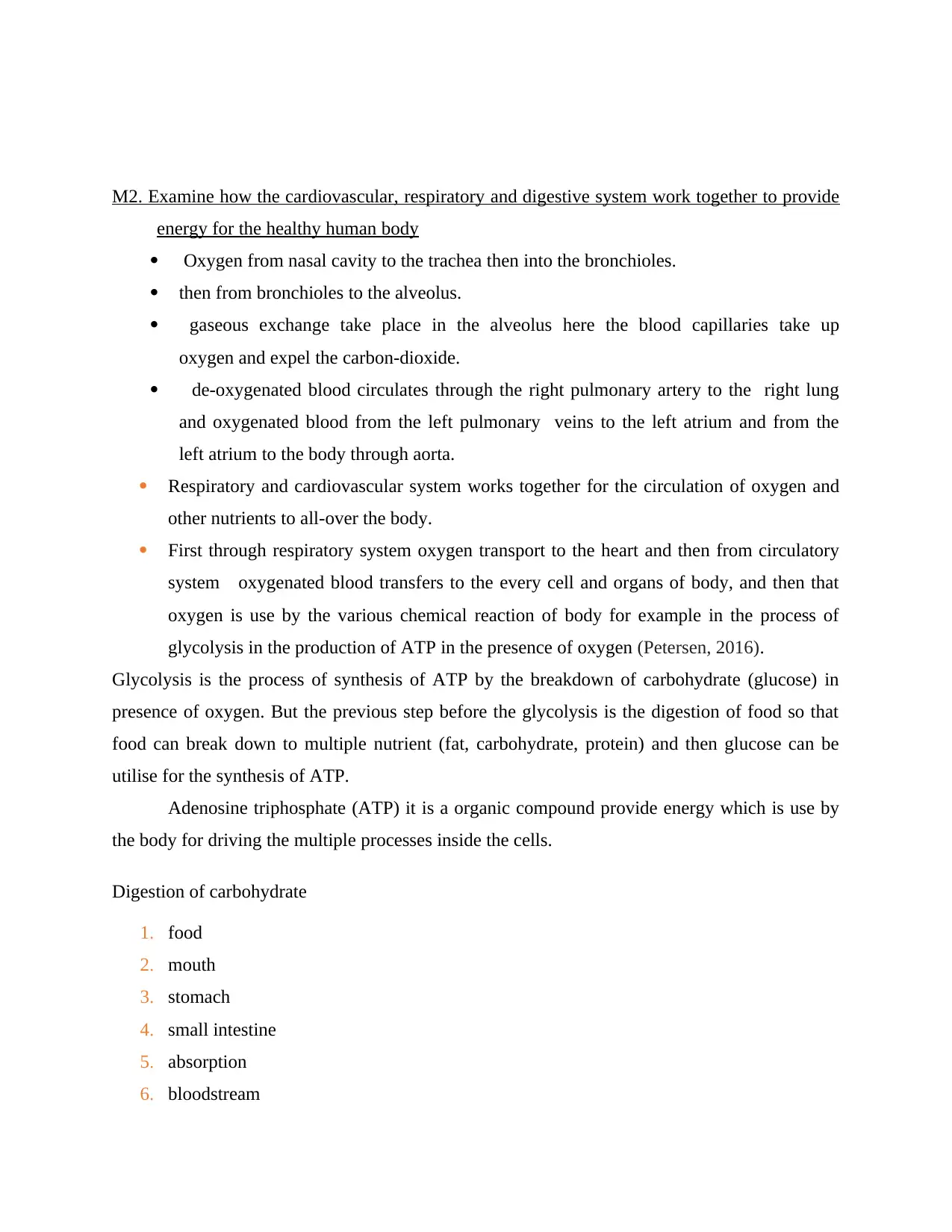
M2. Examine how the cardiovascular, respiratory and digestive system work together to provide
energy for the healthy human body
Oxygen from nasal cavity to the trachea then into the bronchioles.
then from bronchioles to the alveolus.
gaseous exchange take place in the alveolus here the blood capillaries take up
oxygen and expel the carbon-dioxide.
de-oxygenated blood circulates through the right pulmonary artery to the right lung
and oxygenated blood from the left pulmonary veins to the left atrium and from the
left atrium to the body through aorta.
Respiratory and cardiovascular system works together for the circulation of oxygen and
other nutrients to all-over the body.
First through respiratory system oxygen transport to the heart and then from circulatory
system oxygenated blood transfers to the every cell and organs of body, and then that
oxygen is use by the various chemical reaction of body for example in the process of
glycolysis in the production of ATP in the presence of oxygen (Petersen, 2016).
Glycolysis is the process of synthesis of ATP by the breakdown of carbohydrate (glucose) in
presence of oxygen. But the previous step before the glycolysis is the digestion of food so that
food can break down to multiple nutrient (fat, carbohydrate, protein) and then glucose can be
utilise for the synthesis of ATP.
Adenosine triphosphate (ATP) it is a organic compound provide energy which is use by
the body for driving the multiple processes inside the cells.
Digestion of carbohydrate
1. food
2. mouth
3. stomach
4. small intestine
5. absorption
6. bloodstream
energy for the healthy human body
Oxygen from nasal cavity to the trachea then into the bronchioles.
then from bronchioles to the alveolus.
gaseous exchange take place in the alveolus here the blood capillaries take up
oxygen and expel the carbon-dioxide.
de-oxygenated blood circulates through the right pulmonary artery to the right lung
and oxygenated blood from the left pulmonary veins to the left atrium and from the
left atrium to the body through aorta.
Respiratory and cardiovascular system works together for the circulation of oxygen and
other nutrients to all-over the body.
First through respiratory system oxygen transport to the heart and then from circulatory
system oxygenated blood transfers to the every cell and organs of body, and then that
oxygen is use by the various chemical reaction of body for example in the process of
glycolysis in the production of ATP in the presence of oxygen (Petersen, 2016).
Glycolysis is the process of synthesis of ATP by the breakdown of carbohydrate (glucose) in
presence of oxygen. But the previous step before the glycolysis is the digestion of food so that
food can break down to multiple nutrient (fat, carbohydrate, protein) and then glucose can be
utilise for the synthesis of ATP.
Adenosine triphosphate (ATP) it is a organic compound provide energy which is use by
the body for driving the multiple processes inside the cells.
Digestion of carbohydrate
1. food
2. mouth
3. stomach
4. small intestine
5. absorption
6. bloodstream
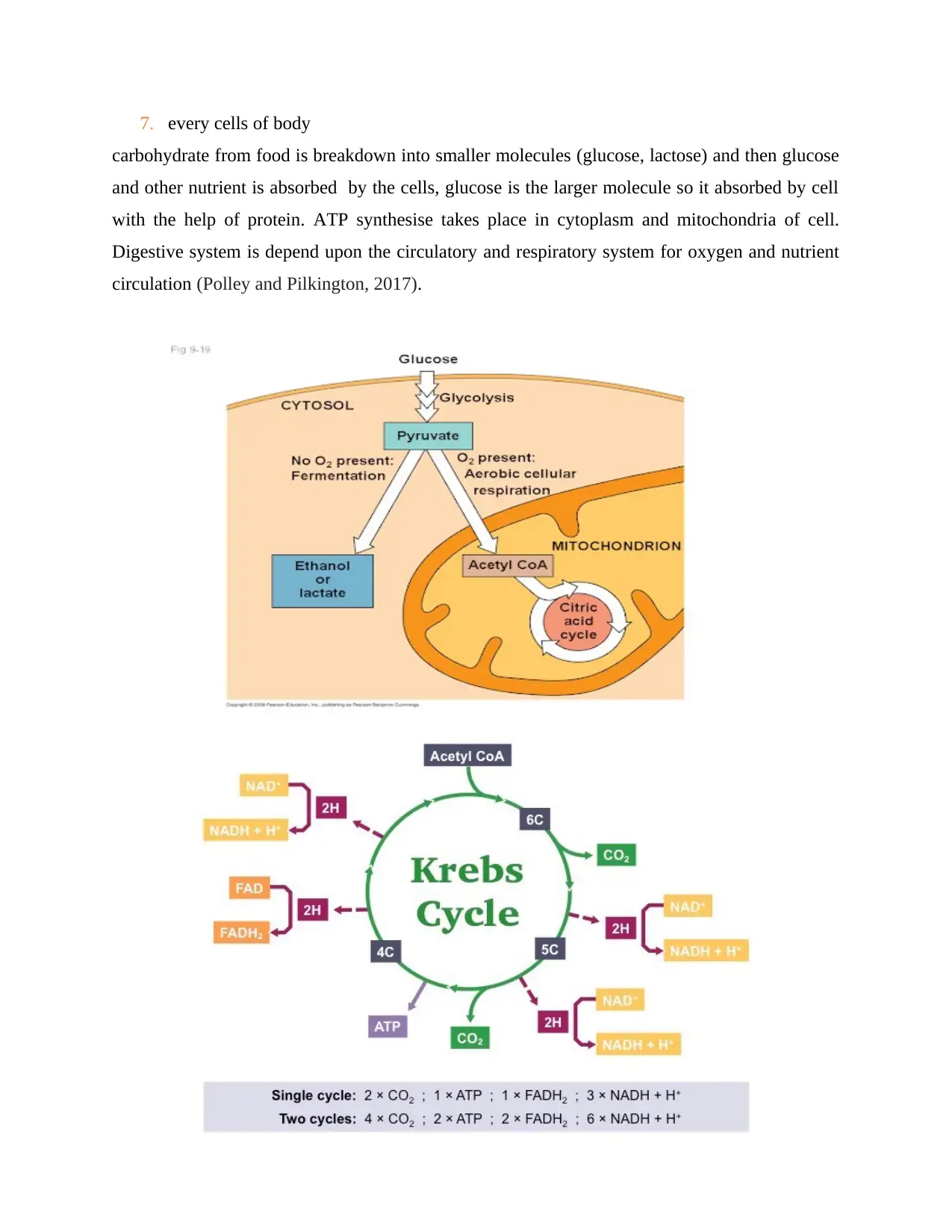
7. every cells of body
carbohydrate from food is breakdown into smaller molecules (glucose, lactose) and then glucose
and other nutrient is absorbed by the cells, glucose is the larger molecule so it absorbed by cell
with the help of protein. ATP synthesise takes place in cytoplasm and mitochondria of cell.
Digestive system is depend upon the circulatory and respiratory system for oxygen and nutrient
circulation (Polley and Pilkington, 2017).
carbohydrate from food is breakdown into smaller molecules (glucose, lactose) and then glucose
and other nutrient is absorbed by the cells, glucose is the larger molecule so it absorbed by cell
with the help of protein. ATP synthesise takes place in cytoplasm and mitochondria of cell.
Digestive system is depend upon the circulatory and respiratory system for oxygen and nutrient
circulation (Polley and Pilkington, 2017).
Secure Best Marks with AI Grader
Need help grading? Try our AI Grader for instant feedback on your assignments.
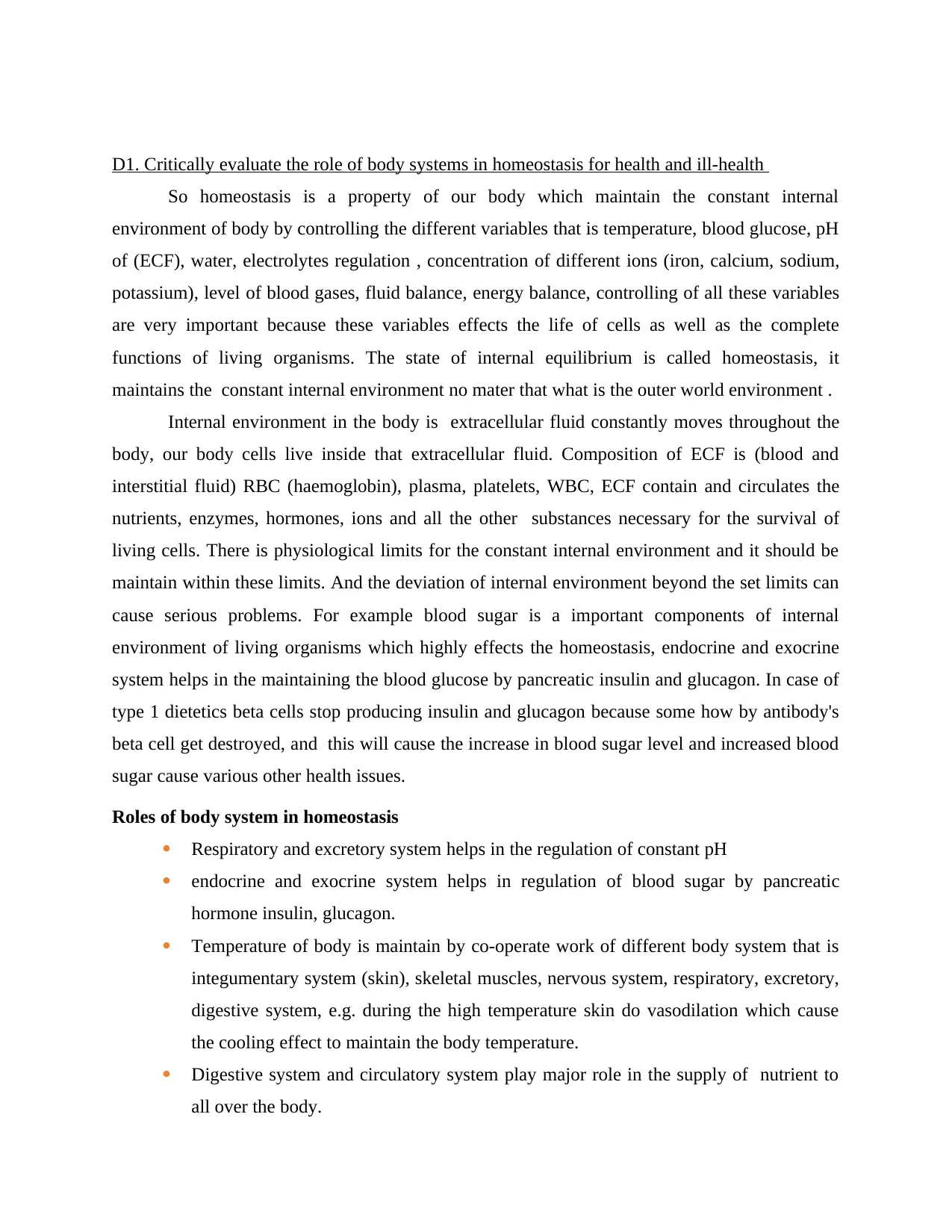
D1. Critically evaluate the role of body systems in homeostasis for health and ill-health
So homeostasis is a property of our body which maintain the constant internal
environment of body by controlling the different variables that is temperature, blood glucose, pH
of (ECF), water, electrolytes regulation , concentration of different ions (iron, calcium, sodium,
potassium), level of blood gases, fluid balance, energy balance, controlling of all these variables
are very important because these variables effects the life of cells as well as the complete
functions of living organisms. The state of internal equilibrium is called homeostasis, it
maintains the constant internal environment no mater that what is the outer world environment .
Internal environment in the body is extracellular fluid constantly moves throughout the
body, our body cells live inside that extracellular fluid. Composition of ECF is (blood and
interstitial fluid) RBC (haemoglobin), plasma, platelets, WBC, ECF contain and circulates the
nutrients, enzymes, hormones, ions and all the other substances necessary for the survival of
living cells. There is physiological limits for the constant internal environment and it should be
maintain within these limits. And the deviation of internal environment beyond the set limits can
cause serious problems. For example blood sugar is a important components of internal
environment of living organisms which highly effects the homeostasis, endocrine and exocrine
system helps in the maintaining the blood glucose by pancreatic insulin and glucagon. In case of
type 1 dietetics beta cells stop producing insulin and glucagon because some how by antibody's
beta cell get destroyed, and this will cause the increase in blood sugar level and increased blood
sugar cause various other health issues.
Roles of body system in homeostasis
Respiratory and excretory system helps in the regulation of constant pH
endocrine and exocrine system helps in regulation of blood sugar by pancreatic
hormone insulin, glucagon.
Temperature of body is maintain by co-operate work of different body system that is
integumentary system (skin), skeletal muscles, nervous system, respiratory, excretory,
digestive system, e.g. during the high temperature skin do vasodilation which cause
the cooling effect to maintain the body temperature.
Digestive system and circulatory system play major role in the supply of nutrient to
all over the body.
So homeostasis is a property of our body which maintain the constant internal
environment of body by controlling the different variables that is temperature, blood glucose, pH
of (ECF), water, electrolytes regulation , concentration of different ions (iron, calcium, sodium,
potassium), level of blood gases, fluid balance, energy balance, controlling of all these variables
are very important because these variables effects the life of cells as well as the complete
functions of living organisms. The state of internal equilibrium is called homeostasis, it
maintains the constant internal environment no mater that what is the outer world environment .
Internal environment in the body is extracellular fluid constantly moves throughout the
body, our body cells live inside that extracellular fluid. Composition of ECF is (blood and
interstitial fluid) RBC (haemoglobin), plasma, platelets, WBC, ECF contain and circulates the
nutrients, enzymes, hormones, ions and all the other substances necessary for the survival of
living cells. There is physiological limits for the constant internal environment and it should be
maintain within these limits. And the deviation of internal environment beyond the set limits can
cause serious problems. For example blood sugar is a important components of internal
environment of living organisms which highly effects the homeostasis, endocrine and exocrine
system helps in the maintaining the blood glucose by pancreatic insulin and glucagon. In case of
type 1 dietetics beta cells stop producing insulin and glucagon because some how by antibody's
beta cell get destroyed, and this will cause the increase in blood sugar level and increased blood
sugar cause various other health issues.
Roles of body system in homeostasis
Respiratory and excretory system helps in the regulation of constant pH
endocrine and exocrine system helps in regulation of blood sugar by pancreatic
hormone insulin, glucagon.
Temperature of body is maintain by co-operate work of different body system that is
integumentary system (skin), skeletal muscles, nervous system, respiratory, excretory,
digestive system, e.g. during the high temperature skin do vasodilation which cause
the cooling effect to maintain the body temperature.
Digestive system and circulatory system play major role in the supply of nutrient to
all over the body.
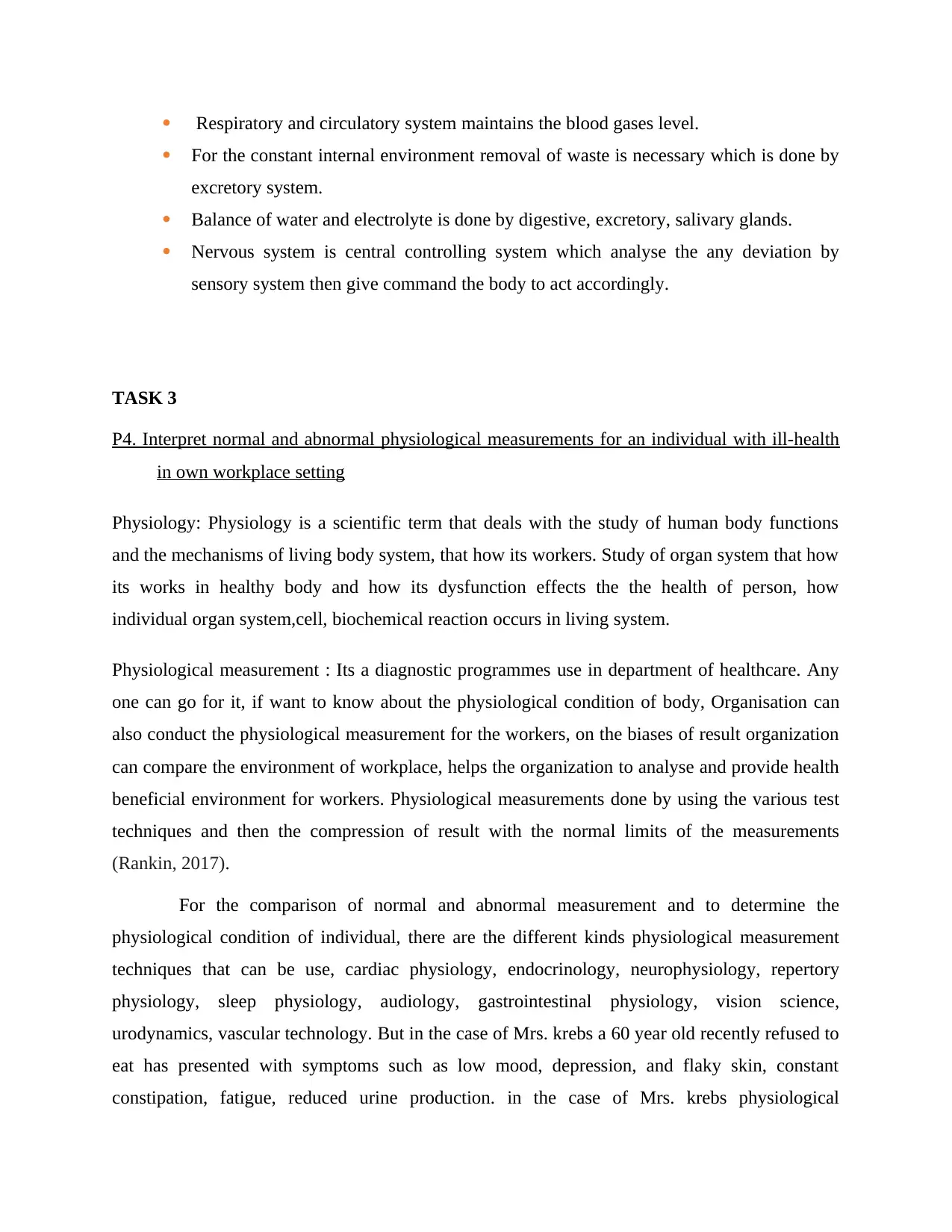
Respiratory and circulatory system maintains the blood gases level.
For the constant internal environment removal of waste is necessary which is done by
excretory system.
Balance of water and electrolyte is done by digestive, excretory, salivary glands.
Nervous system is central controlling system which analyse the any deviation by
sensory system then give command the body to act accordingly.
TASK 3
P4. Interpret normal and abnormal physiological measurements for an individual with ill-health
in own workplace setting
Physiology: Physiology is a scientific term that deals with the study of human body functions
and the mechanisms of living body system, that how its workers. Study of organ system that how
its works in healthy body and how its dysfunction effects the the health of person, how
individual organ system,cell, biochemical reaction occurs in living system.
Physiological measurement : Its a diagnostic programmes use in department of healthcare. Any
one can go for it, if want to know about the physiological condition of body, Organisation can
also conduct the physiological measurement for the workers, on the biases of result organization
can compare the environment of workplace, helps the organization to analyse and provide health
beneficial environment for workers. Physiological measurements done by using the various test
techniques and then the compression of result with the normal limits of the measurements
(Rankin, 2017).
For the comparison of normal and abnormal measurement and to determine the
physiological condition of individual, there are the different kinds physiological measurement
techniques that can be use, cardiac physiology, endocrinology, neurophysiology, repertory
physiology, sleep physiology, audiology, gastrointestinal physiology, vision science,
urodynamics, vascular technology. But in the case of Mrs. krebs a 60 year old recently refused to
eat has presented with symptoms such as low mood, depression, and flaky skin, constant
constipation, fatigue, reduced urine production. in the case of Mrs. krebs physiological
For the constant internal environment removal of waste is necessary which is done by
excretory system.
Balance of water and electrolyte is done by digestive, excretory, salivary glands.
Nervous system is central controlling system which analyse the any deviation by
sensory system then give command the body to act accordingly.
TASK 3
P4. Interpret normal and abnormal physiological measurements for an individual with ill-health
in own workplace setting
Physiology: Physiology is a scientific term that deals with the study of human body functions
and the mechanisms of living body system, that how its workers. Study of organ system that how
its works in healthy body and how its dysfunction effects the the health of person, how
individual organ system,cell, biochemical reaction occurs in living system.
Physiological measurement : Its a diagnostic programmes use in department of healthcare. Any
one can go for it, if want to know about the physiological condition of body, Organisation can
also conduct the physiological measurement for the workers, on the biases of result organization
can compare the environment of workplace, helps the organization to analyse and provide health
beneficial environment for workers. Physiological measurements done by using the various test
techniques and then the compression of result with the normal limits of the measurements
(Rankin, 2017).
For the comparison of normal and abnormal measurement and to determine the
physiological condition of individual, there are the different kinds physiological measurement
techniques that can be use, cardiac physiology, endocrinology, neurophysiology, repertory
physiology, sleep physiology, audiology, gastrointestinal physiology, vision science,
urodynamics, vascular technology. But in the case of Mrs. krebs a 60 year old recently refused to
eat has presented with symptoms such as low mood, depression, and flaky skin, constant
constipation, fatigue, reduced urine production. in the case of Mrs. krebs physiological
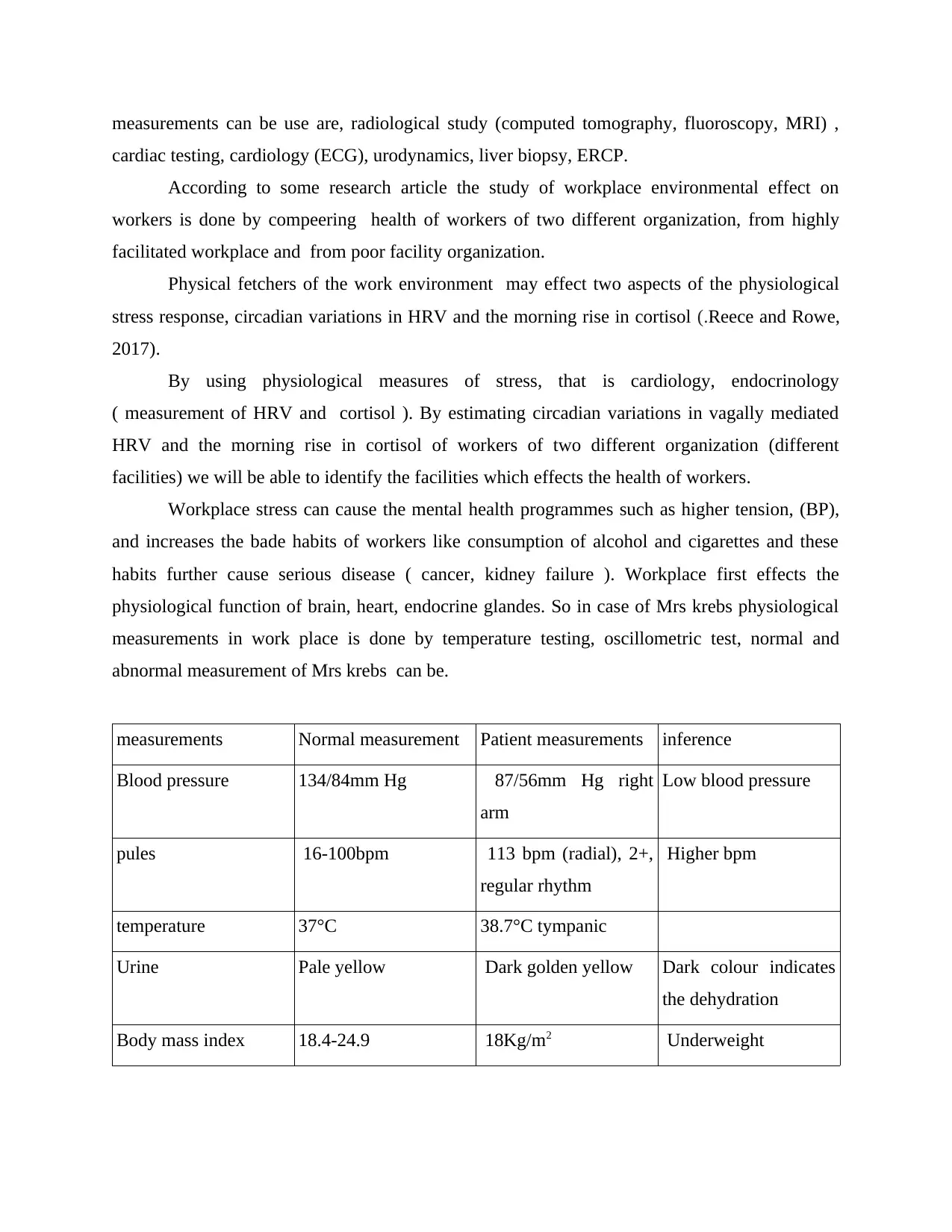
measurements can be use are, radiological study (computed tomography, fluoroscopy, MRI) ,
cardiac testing, cardiology (ECG), urodynamics, liver biopsy, ERCP.
According to some research article the study of workplace environmental effect on
workers is done by compeering health of workers of two different organization, from highly
facilitated workplace and from poor facility organization.
Physical fetchers of the work environment may effect two aspects of the physiological
stress response, circadian variations in HRV and the morning rise in cortisol (.Reece and Rowe,
2017).
By using physiological measures of stress, that is cardiology, endocrinology
( measurement of HRV and cortisol ). By estimating circadian variations in vagally mediated
HRV and the morning rise in cortisol of workers of two different organization (different
facilities) we will be able to identify the facilities which effects the health of workers.
Workplace stress can cause the mental health programmes such as higher tension, (BP),
and increases the bade habits of workers like consumption of alcohol and cigarettes and these
habits further cause serious disease ( cancer, kidney failure ). Workplace first effects the
physiological function of brain, heart, endocrine glandes. So in case of Mrs krebs physiological
measurements in work place is done by temperature testing, oscillometric test, normal and
abnormal measurement of Mrs krebs can be.
measurements Normal measurement Patient measurements inference
Blood pressure 134/84mm Hg 87/56mm Hg right
arm
Low blood pressure
pules 16-100bpm 113 bpm (radial), 2+,
regular rhythm
Higher bpm
temperature 37°C 38.7°C tympanic
Urine Pale yellow Dark golden yellow Dark colour indicates
the dehydration
Body mass index 18.4-24.9 18Kg/m2 Underweight
cardiac testing, cardiology (ECG), urodynamics, liver biopsy, ERCP.
According to some research article the study of workplace environmental effect on
workers is done by compeering health of workers of two different organization, from highly
facilitated workplace and from poor facility organization.
Physical fetchers of the work environment may effect two aspects of the physiological
stress response, circadian variations in HRV and the morning rise in cortisol (.Reece and Rowe,
2017).
By using physiological measures of stress, that is cardiology, endocrinology
( measurement of HRV and cortisol ). By estimating circadian variations in vagally mediated
HRV and the morning rise in cortisol of workers of two different organization (different
facilities) we will be able to identify the facilities which effects the health of workers.
Workplace stress can cause the mental health programmes such as higher tension, (BP),
and increases the bade habits of workers like consumption of alcohol and cigarettes and these
habits further cause serious disease ( cancer, kidney failure ). Workplace first effects the
physiological function of brain, heart, endocrine glandes. So in case of Mrs krebs physiological
measurements in work place is done by temperature testing, oscillometric test, normal and
abnormal measurement of Mrs krebs can be.
measurements Normal measurement Patient measurements inference
Blood pressure 134/84mm Hg 87/56mm Hg right
arm
Low blood pressure
pules 16-100bpm 113 bpm (radial), 2+,
regular rhythm
Higher bpm
temperature 37°C 38.7°C tympanic
Urine Pale yellow Dark golden yellow Dark colour indicates
the dehydration
Body mass index 18.4-24.9 18Kg/m2 Underweight
Paraphrase This Document
Need a fresh take? Get an instant paraphrase of this document with our AI Paraphraser
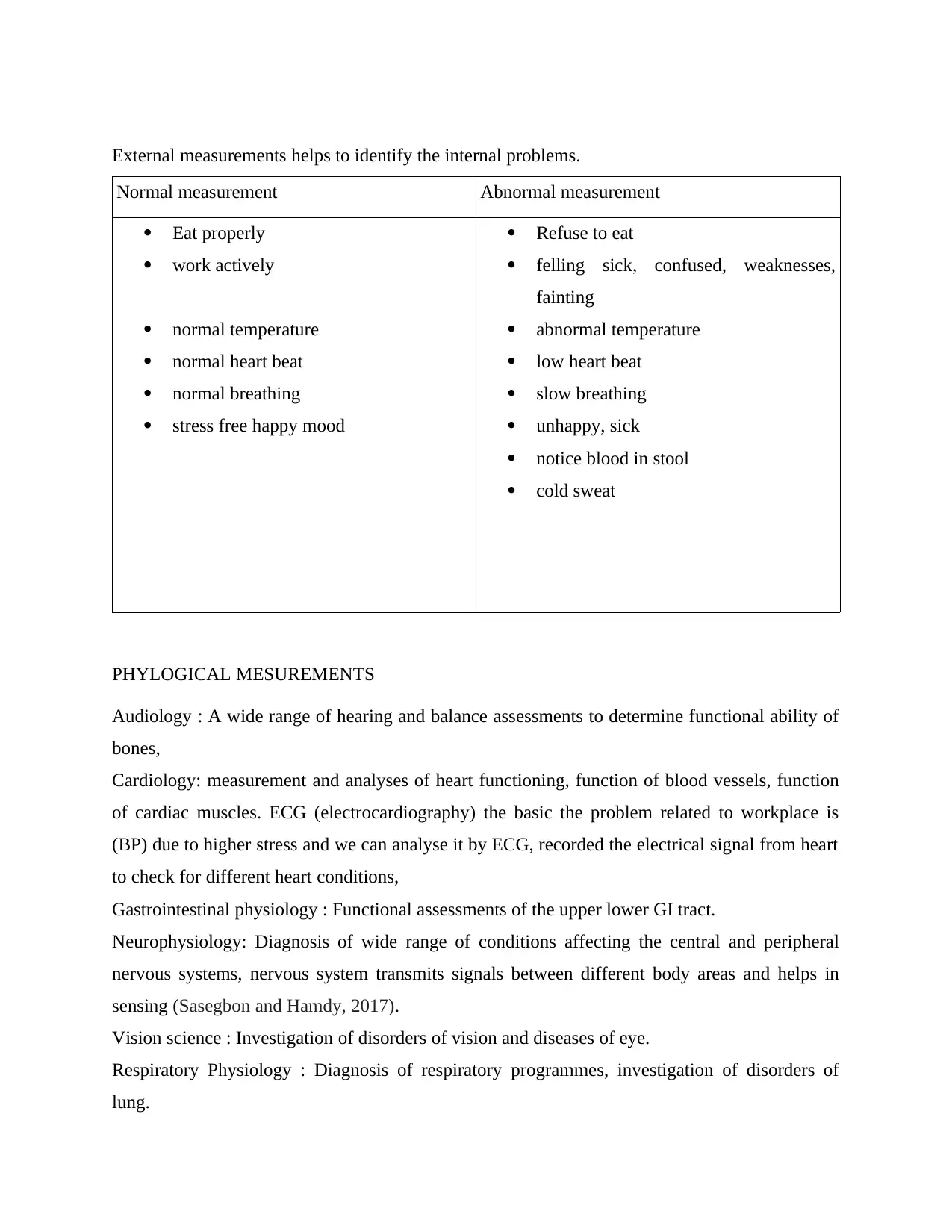
External measurements helps to identify the internal problems.
Normal measurement Abnormal measurement
Eat properly
work actively
normal temperature
normal heart beat
normal breathing
stress free happy mood
Refuse to eat
felling sick, confused, weaknesses,
fainting
abnormal temperature
low heart beat
slow breathing
unhappy, sick
notice blood in stool
cold sweat
PHYLOGICAL MESUREMENTS
Audiology : A wide range of hearing and balance assessments to determine functional ability of
bones,
Cardiology: measurement and analyses of heart functioning, function of blood vessels, function
of cardiac muscles. ECG (electrocardiography) the basic the problem related to workplace is
(BP) due to higher stress and we can analyse it by ECG, recorded the electrical signal from heart
to check for different heart conditions,
Gastrointestinal physiology : Functional assessments of the upper lower GI tract.
Neurophysiology: Diagnosis of wide range of conditions affecting the central and peripheral
nervous systems, nervous system transmits signals between different body areas and helps in
sensing (Sasegbon and Hamdy, 2017).
Vision science : Investigation of disorders of vision and diseases of eye.
Respiratory Physiology : Diagnosis of respiratory programmes, investigation of disorders of
lung.
Normal measurement Abnormal measurement
Eat properly
work actively
normal temperature
normal heart beat
normal breathing
stress free happy mood
Refuse to eat
felling sick, confused, weaknesses,
fainting
abnormal temperature
low heart beat
slow breathing
unhappy, sick
notice blood in stool
cold sweat
PHYLOGICAL MESUREMENTS
Audiology : A wide range of hearing and balance assessments to determine functional ability of
bones,
Cardiology: measurement and analyses of heart functioning, function of blood vessels, function
of cardiac muscles. ECG (electrocardiography) the basic the problem related to workplace is
(BP) due to higher stress and we can analyse it by ECG, recorded the electrical signal from heart
to check for different heart conditions,
Gastrointestinal physiology : Functional assessments of the upper lower GI tract.
Neurophysiology: Diagnosis of wide range of conditions affecting the central and peripheral
nervous systems, nervous system transmits signals between different body areas and helps in
sensing (Sasegbon and Hamdy, 2017).
Vision science : Investigation of disorders of vision and diseases of eye.
Respiratory Physiology : Diagnosis of respiratory programmes, investigation of disorders of
lung.
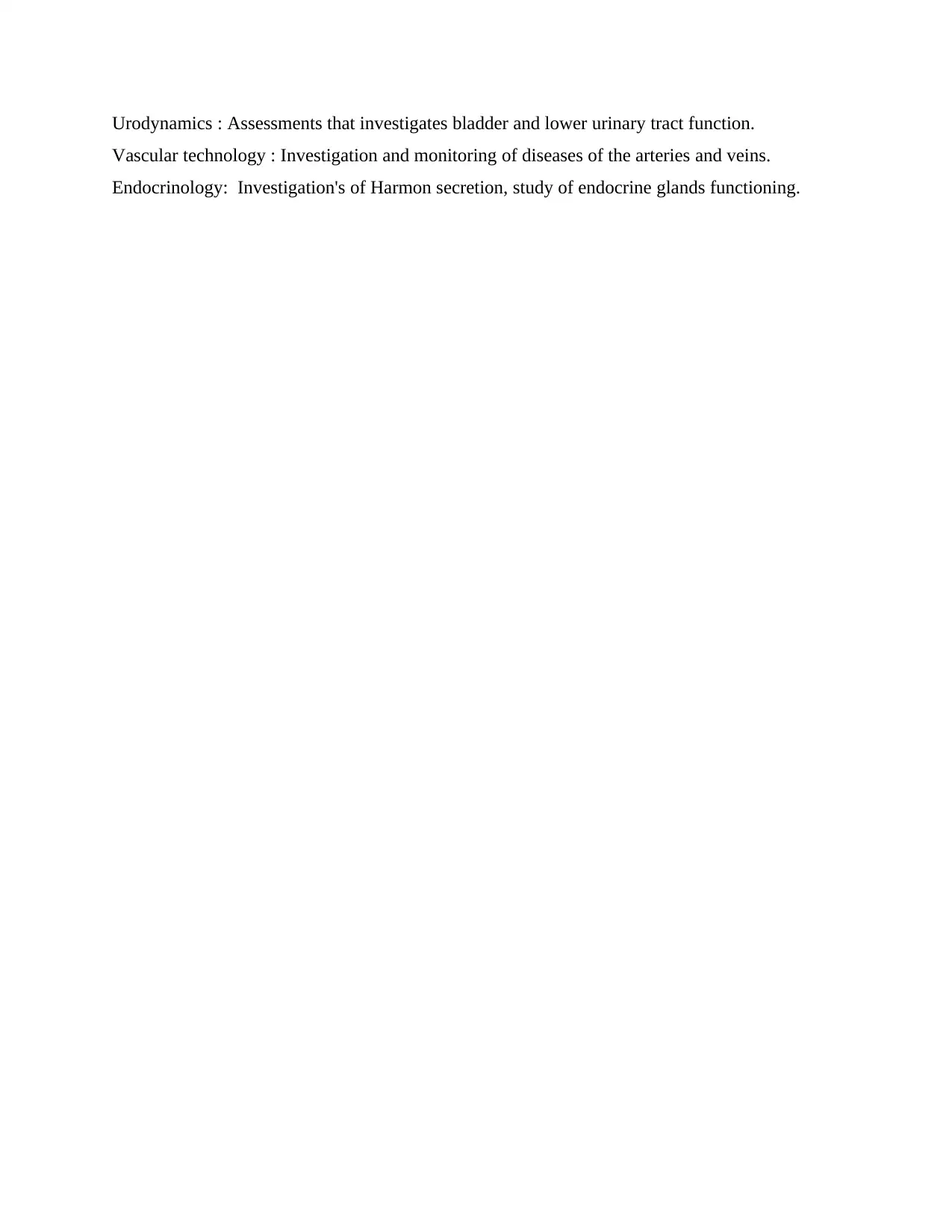
Urodynamics : Assessments that investigates bladder and lower urinary tract function.
Vascular technology : Investigation and monitoring of diseases of the arteries and veins.
Endocrinology: Investigation's of Harmon secretion, study of endocrine glands functioning.
Vascular technology : Investigation and monitoring of diseases of the arteries and veins.
Endocrinology: Investigation's of Harmon secretion, study of endocrine glands functioning.

M3. Justify actions taken when physiological measurements are outside normal limits
Trough physiological measurements it will be possible to analyse that the all physiological
system of body is function properly or not, according to that we can take actions to improve the
non-functioning of body system e.g. ECG, EMG ( physiological measurement) is done for the
analysis of the proper function of heart and to analyse the effect of stress on heart, if BP Is low
then various precautions and interventions is done that is DASH dietary pattern, exercise in Daly
routine, regular medical test, sodium enhancement and potassium reduction, proper amount of
salt, all these intervention will defiantly improve the health of individual, because diet, living
environment, Daly routine effect the health accordingly so right amount of salt in the diet,
nutritional food, exercise, meditation, helps in improvement of health.
TASK 4
P5 : Prepare a risk assessment which minimises harm to the health of an individual with ill-
health in own workplace setting.
Risk assessment
Risk assessment is process of analysing hazards and risk factors that have the potential to cause
harm, and the development of safety maser against those hazard's.
Five steps of risk assessment are, identify the hazards, decide who might be harmed and how,
evaluate the risk and decide preparation, record findings and implement them, update
assessment.
A safety risk assessment is the process of creating a safe, healthy workplace for
employees. The first step is to identify health hazards and risk then implementation of safety
masers. Before the risk assessment health safety policy is important (Thompson, 2019).
Now we are going to make risk assessment for Mrs krebs with ill-health, to minimises the
harm in own workplace setting. First we have to analyse the hazards and than have to make
safety masers, apply.
Hazard's How might it effects Safety measures
In-proper medications Effects the recovery of person
health
Should take proper
medications
Dirty carpets and tiles Dust, pathogens, allergic Clean and sensitized carpets
Trough physiological measurements it will be possible to analyse that the all physiological
system of body is function properly or not, according to that we can take actions to improve the
non-functioning of body system e.g. ECG, EMG ( physiological measurement) is done for the
analysis of the proper function of heart and to analyse the effect of stress on heart, if BP Is low
then various precautions and interventions is done that is DASH dietary pattern, exercise in Daly
routine, regular medical test, sodium enhancement and potassium reduction, proper amount of
salt, all these intervention will defiantly improve the health of individual, because diet, living
environment, Daly routine effect the health accordingly so right amount of salt in the diet,
nutritional food, exercise, meditation, helps in improvement of health.
TASK 4
P5 : Prepare a risk assessment which minimises harm to the health of an individual with ill-
health in own workplace setting.
Risk assessment
Risk assessment is process of analysing hazards and risk factors that have the potential to cause
harm, and the development of safety maser against those hazard's.
Five steps of risk assessment are, identify the hazards, decide who might be harmed and how,
evaluate the risk and decide preparation, record findings and implement them, update
assessment.
A safety risk assessment is the process of creating a safe, healthy workplace for
employees. The first step is to identify health hazards and risk then implementation of safety
masers. Before the risk assessment health safety policy is important (Thompson, 2019).
Now we are going to make risk assessment for Mrs krebs with ill-health, to minimises the
harm in own workplace setting. First we have to analyse the hazards and than have to make
safety masers, apply.
Hazard's How might it effects Safety measures
In-proper medications Effects the recovery of person
health
Should take proper
medications
Dirty carpets and tiles Dust, pathogens, allergic Clean and sensitized carpets
Secure Best Marks with AI Grader
Need help grading? Try our AI Grader for instant feedback on your assignments.

particle from dirty carpets and
tiles when comes in contact
with ill person, can cause more
harm, because as individual is
already ill and the immune
system is weak so it can cause
more damage to immune
system an individual health
(Townsend and Morgan, 2017).
and tiles, and it is necessary
for the individual take care
of it, to be away from dirty
things
Overcrowding Overcrowding can cause rapid
spread of airborne diseases
from one person to another.
Make sufficient space in
office for every employees.
Lake of sunlight Less light exposure can cause
more sickness, exposure to light
also effects mood, alertness and
metabolism
Proper ventilation and
windows in workplace.
Work lode (stress) Higher work lode can cause
hypertension effects the blood
pressure of individual
A correct work flow for
every worker according to
the capacity and health
problems
Insufficient ventilation Insufficient ventilation leads to
the build of carbon monoxide,
this causes microorganisms and
germs to circulate, dealings to
the breathing problems.
Proper ventilation and open
environment with proper
circulation of air.
Unclean
workplace
It can cause the spread of germs
from one person to other and
increase the chance of allergy.
Clean and sanitized table of
every employ and the
substance of work place
Unhygienic food Food of outdoors can cause Should eat hygienic and
tiles when comes in contact
with ill person, can cause more
harm, because as individual is
already ill and the immune
system is weak so it can cause
more damage to immune
system an individual health
(Townsend and Morgan, 2017).
and tiles, and it is necessary
for the individual take care
of it, to be away from dirty
things
Overcrowding Overcrowding can cause rapid
spread of airborne diseases
from one person to another.
Make sufficient space in
office for every employees.
Lake of sunlight Less light exposure can cause
more sickness, exposure to light
also effects mood, alertness and
metabolism
Proper ventilation and
windows in workplace.
Work lode (stress) Higher work lode can cause
hypertension effects the blood
pressure of individual
A correct work flow for
every worker according to
the capacity and health
problems
Insufficient ventilation Insufficient ventilation leads to
the build of carbon monoxide,
this causes microorganisms and
germs to circulate, dealings to
the breathing problems.
Proper ventilation and open
environment with proper
circulation of air.
Unclean
workplace
It can cause the spread of germs
from one person to other and
increase the chance of allergy.
Clean and sanitized table of
every employ and the
substance of work place
Unhygienic food Food of outdoors can cause Should eat hygienic and
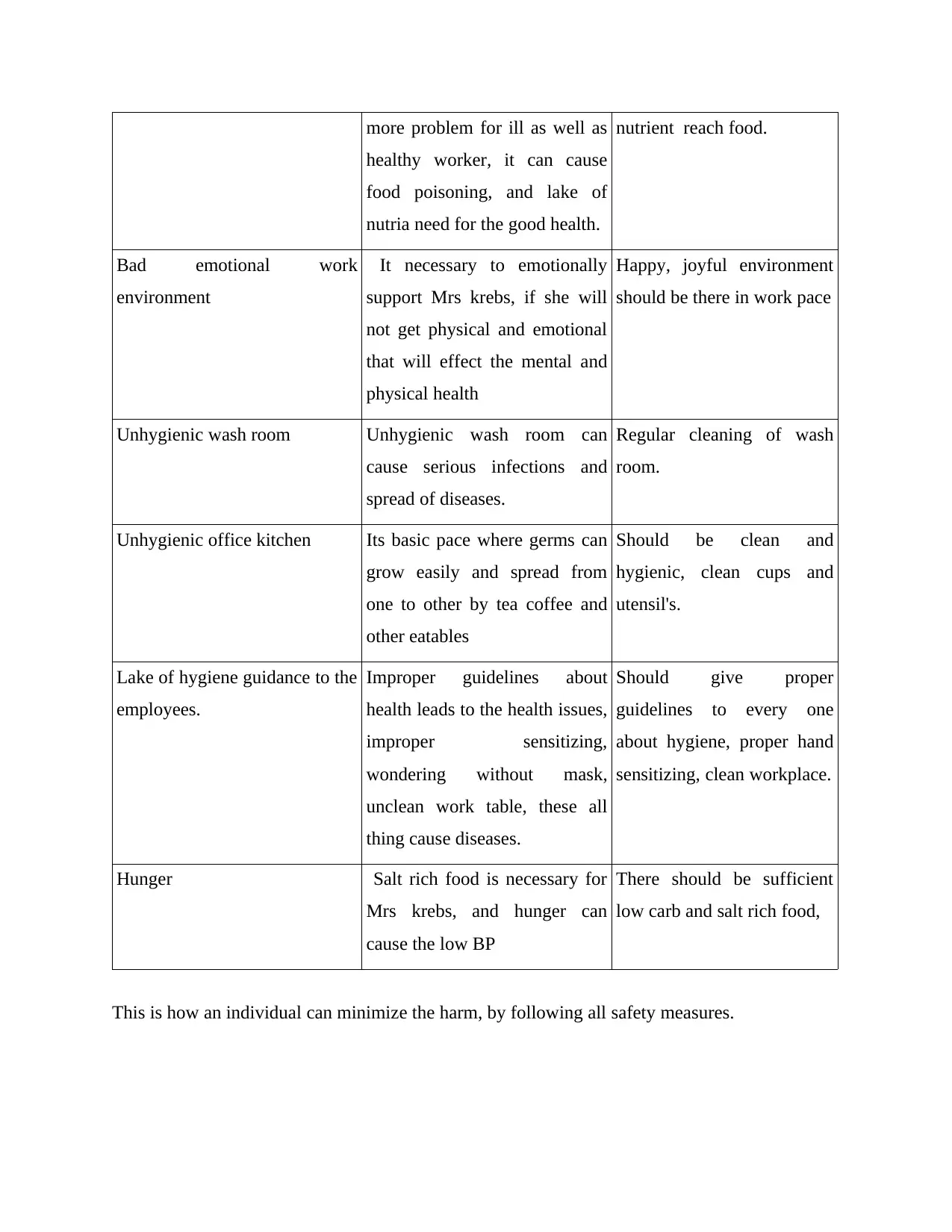
more problem for ill as well as
healthy worker, it can cause
food poisoning, and lake of
nutria need for the good health.
nutrient reach food.
Bad emotional work
environment
It necessary to emotionally
support Mrs krebs, if she will
not get physical and emotional
that will effect the mental and
physical health
Happy, joyful environment
should be there in work pace
Unhygienic wash room Unhygienic wash room can
cause serious infections and
spread of diseases.
Regular cleaning of wash
room.
Unhygienic office kitchen Its basic pace where germs can
grow easily and spread from
one to other by tea coffee and
other eatables
Should be clean and
hygienic, clean cups and
utensil's.
Lake of hygiene guidance to the
employees.
Improper guidelines about
health leads to the health issues,
improper sensitizing,
wondering without mask,
unclean work table, these all
thing cause diseases.
Should give proper
guidelines to every one
about hygiene, proper hand
sensitizing, clean workplace.
Hunger Salt rich food is necessary for
Mrs krebs, and hunger can
cause the low BP
There should be sufficient
low carb and salt rich food,
This is how an individual can minimize the harm, by following all safety measures.
healthy worker, it can cause
food poisoning, and lake of
nutria need for the good health.
nutrient reach food.
Bad emotional work
environment
It necessary to emotionally
support Mrs krebs, if she will
not get physical and emotional
that will effect the mental and
physical health
Happy, joyful environment
should be there in work pace
Unhygienic wash room Unhygienic wash room can
cause serious infections and
spread of diseases.
Regular cleaning of wash
room.
Unhygienic office kitchen Its basic pace where germs can
grow easily and spread from
one to other by tea coffee and
other eatables
Should be clean and
hygienic, clean cups and
utensil's.
Lake of hygiene guidance to the
employees.
Improper guidelines about
health leads to the health issues,
improper sensitizing,
wondering without mask,
unclean work table, these all
thing cause diseases.
Should give proper
guidelines to every one
about hygiene, proper hand
sensitizing, clean workplace.
Hunger Salt rich food is necessary for
Mrs krebs, and hunger can
cause the low BP
There should be sufficient
low carb and salt rich food,
This is how an individual can minimize the harm, by following all safety measures.
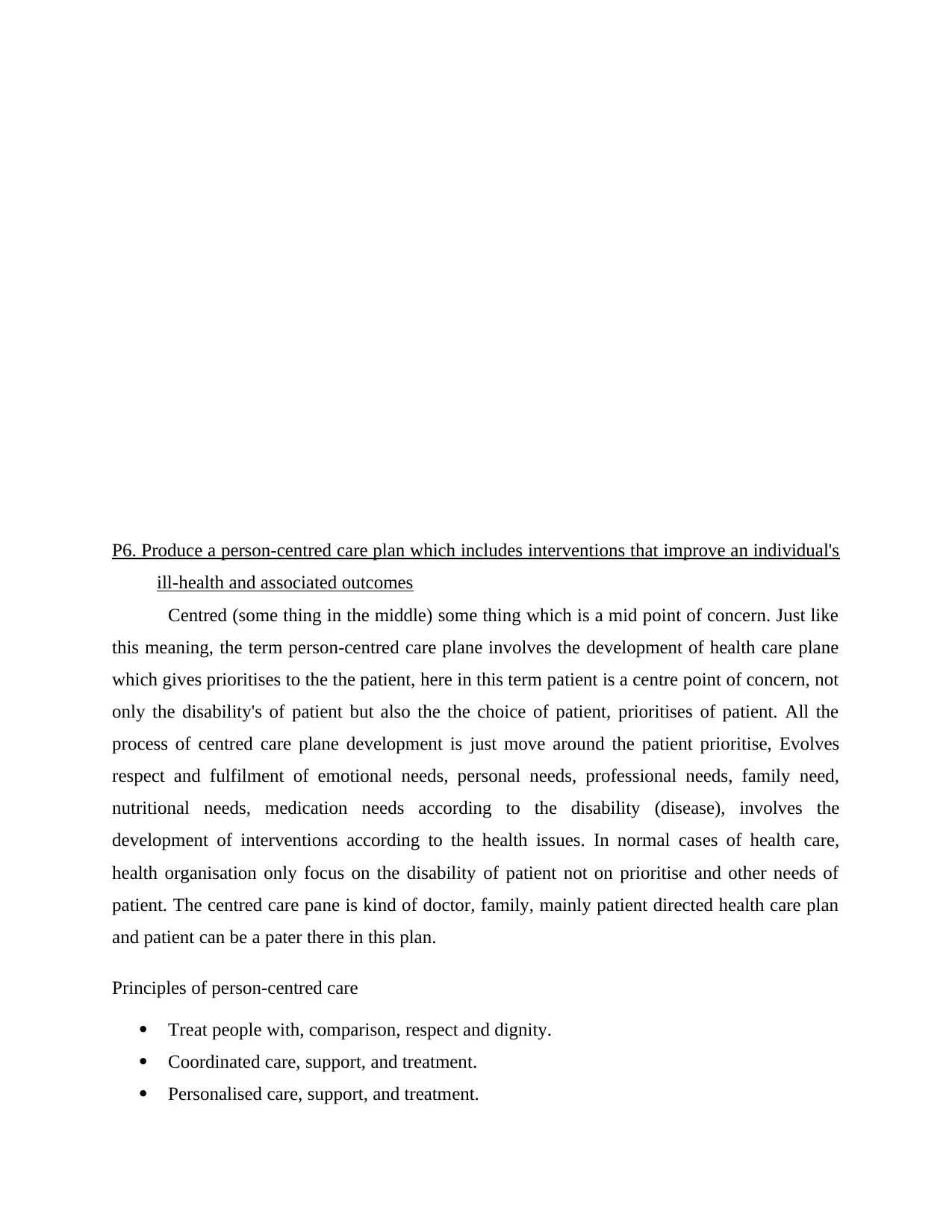
P6. Produce a person-centred care plan which includes interventions that improve an individual's
ill-health and associated outcomes
Centred (some thing in the middle) some thing which is a mid point of concern. Just like
this meaning, the term person-centred care plane involves the development of health care plane
which gives prioritises to the the patient, here in this term patient is a centre point of concern, not
only the disability's of patient but also the the choice of patient, prioritises of patient. All the
process of centred care plane development is just move around the patient prioritise, Evolves
respect and fulfilment of emotional needs, personal needs, professional needs, family need,
nutritional needs, medication needs according to the disability (disease), involves the
development of interventions according to the health issues. In normal cases of health care,
health organisation only focus on the disability of patient not on prioritise and other needs of
patient. The centred care pane is kind of doctor, family, mainly patient directed health care plan
and patient can be a pater there in this plan.
Principles of person-centred care
Treat people with, comparison, respect and dignity.
Coordinated care, support, and treatment.
Personalised care, support, and treatment.
ill-health and associated outcomes
Centred (some thing in the middle) some thing which is a mid point of concern. Just like
this meaning, the term person-centred care plane involves the development of health care plane
which gives prioritises to the the patient, here in this term patient is a centre point of concern, not
only the disability's of patient but also the the choice of patient, prioritises of patient. All the
process of centred care plane development is just move around the patient prioritise, Evolves
respect and fulfilment of emotional needs, personal needs, professional needs, family need,
nutritional needs, medication needs according to the disability (disease), involves the
development of interventions according to the health issues. In normal cases of health care,
health organisation only focus on the disability of patient not on prioritise and other needs of
patient. The centred care pane is kind of doctor, family, mainly patient directed health care plan
and patient can be a pater there in this plan.
Principles of person-centred care
Treat people with, comparison, respect and dignity.
Coordinated care, support, and treatment.
Personalised care, support, and treatment.
Paraphrase This Document
Need a fresh take? Get an instant paraphrase of this document with our AI Paraphraser
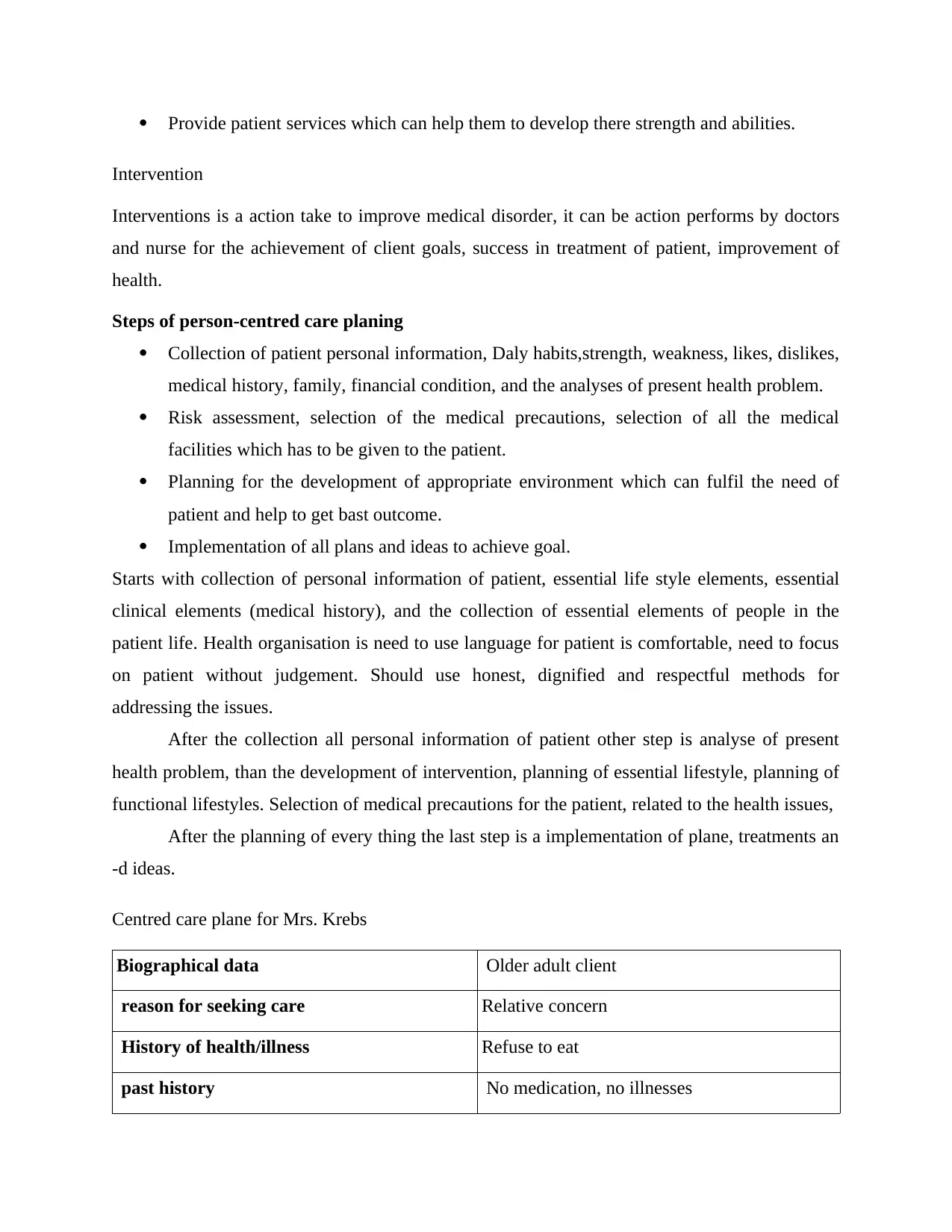
Provide patient services which can help them to develop there strength and abilities.
Intervention
Interventions is a action take to improve medical disorder, it can be action performs by doctors
and nurse for the achievement of client goals, success in treatment of patient, improvement of
health.
Steps of person-centred care planing
Collection of patient personal information, Daly habits,strength, weakness, likes, dislikes,
medical history, family, financial condition, and the analyses of present health problem.
Risk assessment, selection of the medical precautions, selection of all the medical
facilities which has to be given to the patient.
Planning for the development of appropriate environment which can fulfil the need of
patient and help to get bast outcome.
Implementation of all plans and ideas to achieve goal.
Starts with collection of personal information of patient, essential life style elements, essential
clinical elements (medical history), and the collection of essential elements of people in the
patient life. Health organisation is need to use language for patient is comfortable, need to focus
on patient without judgement. Should use honest, dignified and respectful methods for
addressing the issues.
After the collection all personal information of patient other step is analyse of present
health problem, than the development of intervention, planning of essential lifestyle, planning of
functional lifestyles. Selection of medical precautions for the patient, related to the health issues,
After the planning of every thing the last step is a implementation of plane, treatments an
-d ideas.
Centred care plane for Mrs. Krebs
Biographical data Older adult client
reason for seeking care Relative concern
History of health/illness Refuse to eat
past history No medication, no illnesses
Intervention
Interventions is a action take to improve medical disorder, it can be action performs by doctors
and nurse for the achievement of client goals, success in treatment of patient, improvement of
health.
Steps of person-centred care planing
Collection of patient personal information, Daly habits,strength, weakness, likes, dislikes,
medical history, family, financial condition, and the analyses of present health problem.
Risk assessment, selection of the medical precautions, selection of all the medical
facilities which has to be given to the patient.
Planning for the development of appropriate environment which can fulfil the need of
patient and help to get bast outcome.
Implementation of all plans and ideas to achieve goal.
Starts with collection of personal information of patient, essential life style elements, essential
clinical elements (medical history), and the collection of essential elements of people in the
patient life. Health organisation is need to use language for patient is comfortable, need to focus
on patient without judgement. Should use honest, dignified and respectful methods for
addressing the issues.
After the collection all personal information of patient other step is analyse of present
health problem, than the development of intervention, planning of essential lifestyle, planning of
functional lifestyles. Selection of medical precautions for the patient, related to the health issues,
After the planning of every thing the last step is a implementation of plane, treatments an
-d ideas.
Centred care plane for Mrs. Krebs
Biographical data Older adult client
reason for seeking care Relative concern
History of health/illness Refuse to eat
past history No medication, no illnesses
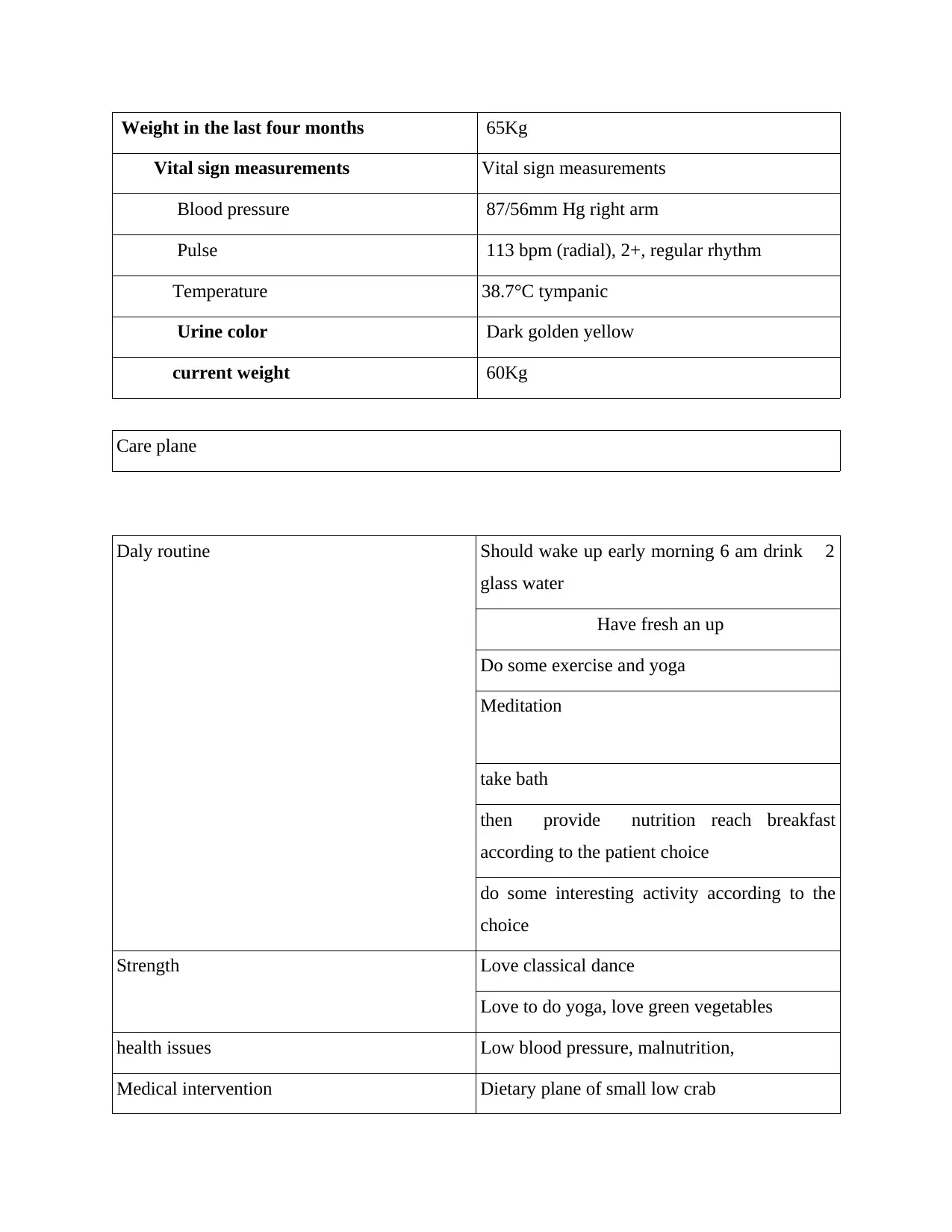
Weight in the last four months 65Kg
Vital sign measurements Vital sign measurements
Blood pressure 87/56mm Hg right arm
Pulse 113 bpm (radial), 2+, regular rhythm
Temperature 38.7°C tympanic
Urine color Dark golden yellow
current weight 60Kg
Care plane
Daly routine Should wake up early morning 6 am drink 2
glass water
Have fresh an up
Do some exercise and yoga
Meditation
take bath
then provide nutrition reach breakfast
according to the patient choice
do some interesting activity according to the
choice
Strength Love classical dance
Love to do yoga, love green vegetables
health issues Low blood pressure, malnutrition,
Medical intervention Dietary plane of small low crab
Vital sign measurements Vital sign measurements
Blood pressure 87/56mm Hg right arm
Pulse 113 bpm (radial), 2+, regular rhythm
Temperature 38.7°C tympanic
Urine color Dark golden yellow
current weight 60Kg
Care plane
Daly routine Should wake up early morning 6 am drink 2
glass water
Have fresh an up
Do some exercise and yoga
Meditation
take bath
then provide nutrition reach breakfast
according to the patient choice
do some interesting activity according to the
choice
Strength Love classical dance
Love to do yoga, love green vegetables
health issues Low blood pressure, malnutrition,
Medical intervention Dietary plane of small low crab
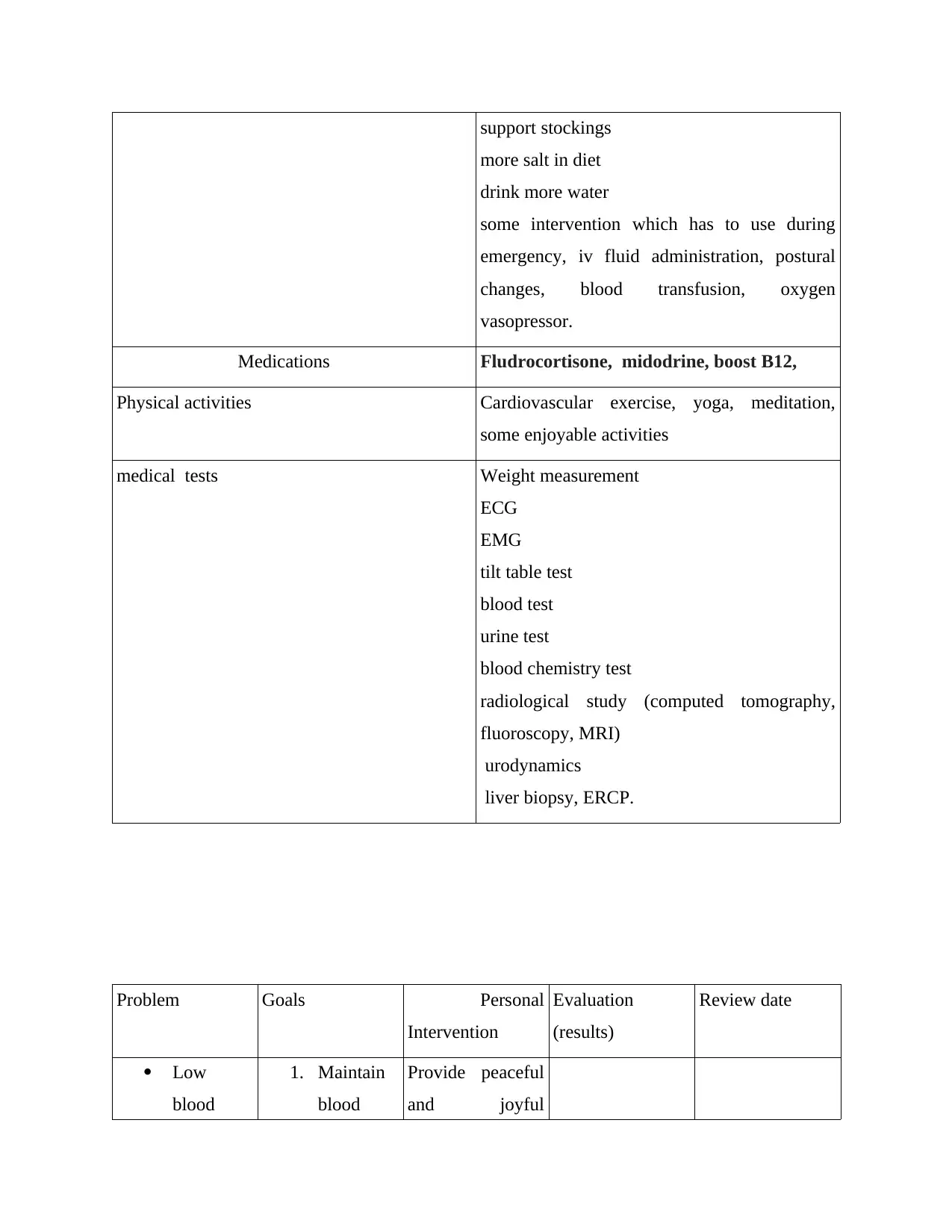
support stockings
more salt in diet
drink more water
some intervention which has to use during
emergency, iv fluid administration, postural
changes, blood transfusion, oxygen
vasopressor.
Medications Fludrocortisone, midodrine, boost B12,
Physical activities Cardiovascular exercise, yoga, meditation,
some enjoyable activities
medical tests Weight measurement
ECG
EMG
tilt table test
blood test
urine test
blood chemistry test
radiological study (computed tomography,
fluoroscopy, MRI)
urodynamics
liver biopsy, ERCP.
Problem Goals Personal
Intervention
Evaluation
(results)
Review date
Low
blood
1. Maintain
blood
Provide peaceful
and joyful
more salt in diet
drink more water
some intervention which has to use during
emergency, iv fluid administration, postural
changes, blood transfusion, oxygen
vasopressor.
Medications Fludrocortisone, midodrine, boost B12,
Physical activities Cardiovascular exercise, yoga, meditation,
some enjoyable activities
medical tests Weight measurement
ECG
EMG
tilt table test
blood test
urine test
blood chemistry test
radiological study (computed tomography,
fluoroscopy, MRI)
urodynamics
liver biopsy, ERCP.
Problem Goals Personal
Intervention
Evaluation
(results)
Review date
Low
blood
1. Maintain
blood
Provide peaceful
and joyful
Secure Best Marks with AI Grader
Need help grading? Try our AI Grader for instant feedback on your assignments.
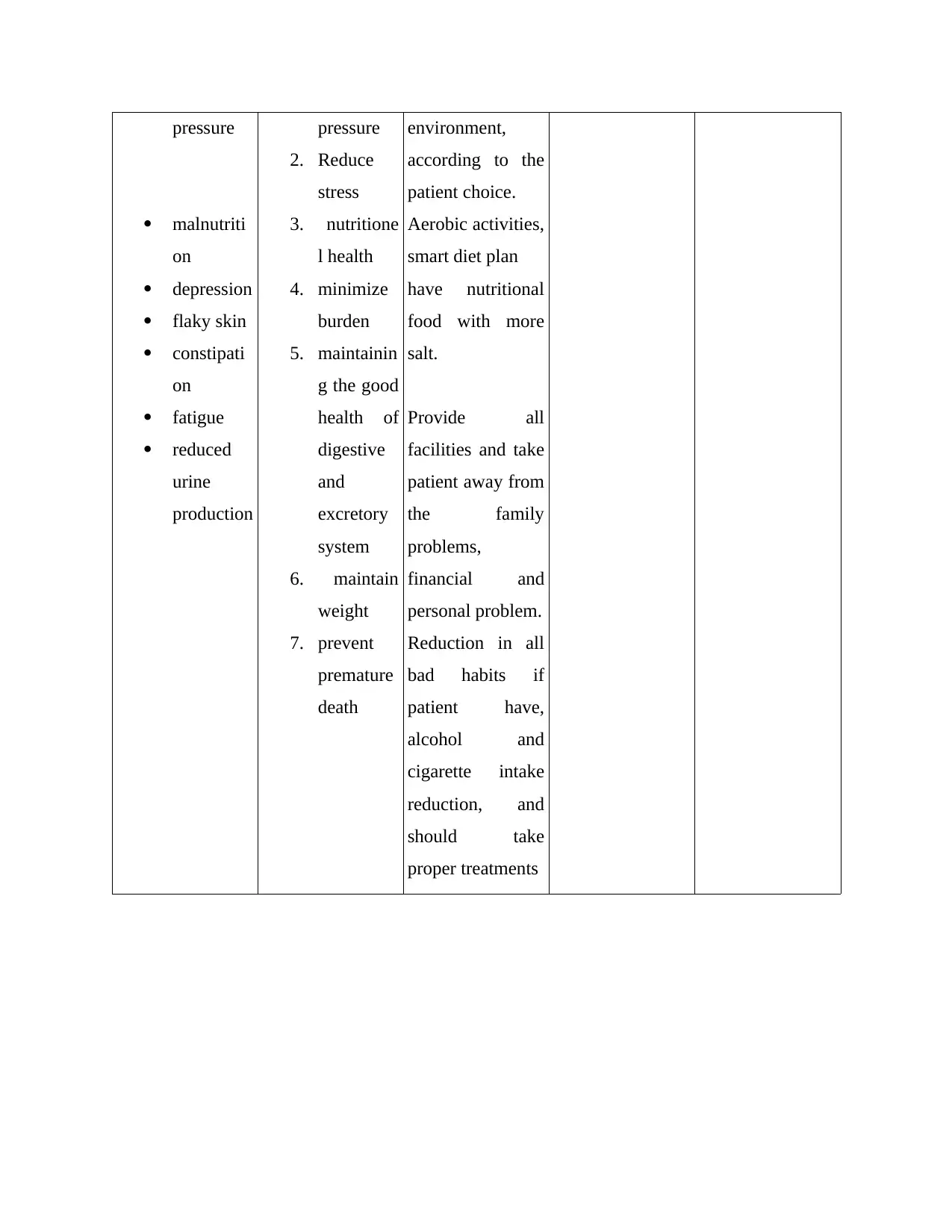
pressure
malnutriti
on
depression
flaky skin
constipati
on
fatigue
reduced
urine
production
pressure
2. Reduce
stress
3. nutritione
l health
4. minimize
burden
5. maintainin
g the good
health of
digestive
and
excretory
system
6. maintain
weight
7. prevent
premature
death
environment,
according to the
patient choice.
Aerobic activities,
smart diet plan
have nutritional
food with more
salt.
Provide all
facilities and take
patient away from
the family
problems,
financial and
personal problem.
Reduction in all
bad habits if
patient have,
alcohol and
cigarette intake
reduction, and
should take
proper treatments
malnutriti
on
depression
flaky skin
constipati
on
fatigue
reduced
urine
production
pressure
2. Reduce
stress
3. nutritione
l health
4. minimize
burden
5. maintainin
g the good
health of
digestive
and
excretory
system
6. maintain
weight
7. prevent
premature
death
environment,
according to the
patient choice.
Aerobic activities,
smart diet plan
have nutritional
food with more
salt.
Provide all
facilities and take
patient away from
the family
problems,
financial and
personal problem.
Reduction in all
bad habits if
patient have,
alcohol and
cigarette intake
reduction, and
should take
proper treatments
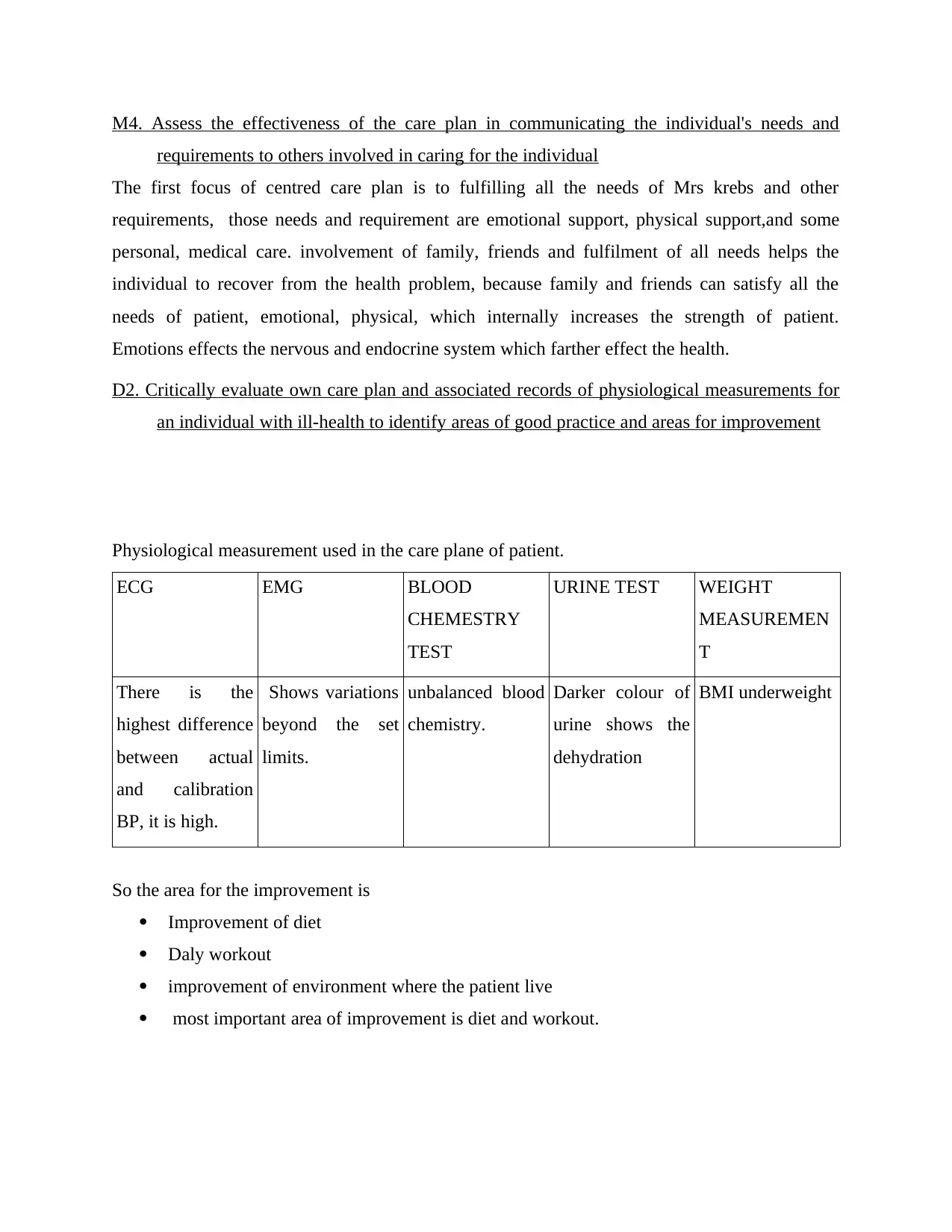
M4. Assess the effectiveness of the care plan in communicating the individual's needs and
requirements to others involved in caring for the individual
The first focus of centred care plan is to fulfilling all the needs of Mrs krebs and other
requirements, those needs and requirement are emotional support, physical support,and some
personal, medical care. involvement of family, friends and fulfilment of all needs helps the
individual to recover from the health problem, because family and friends can satisfy all the
needs of patient, emotional, physical, which internally increases the strength of patient.
Emotions effects the nervous and endocrine system which farther effect the health.
D2. Critically evaluate own care plan and associated records of physiological measurements for
an individual with ill-health to identify areas of good practice and areas for improvement
Physiological measurement used in the care plane of patient.
ECG EMG BLOOD
CHEMESTRY
TEST
URINE TEST WEIGHT
MEASUREMEN
T
There is the
highest difference
between actual
and calibration
BP, it is high.
Shows variations
beyond the set
limits.
unbalanced blood
chemistry.
Darker colour of
urine shows the
dehydration
BMI underweight
So the area for the improvement is
Improvement of diet
Daly workout
improvement of environment where the patient live
most important area of improvement is diet and workout.
requirements to others involved in caring for the individual
The first focus of centred care plan is to fulfilling all the needs of Mrs krebs and other
requirements, those needs and requirement are emotional support, physical support,and some
personal, medical care. involvement of family, friends and fulfilment of all needs helps the
individual to recover from the health problem, because family and friends can satisfy all the
needs of patient, emotional, physical, which internally increases the strength of patient.
Emotions effects the nervous and endocrine system which farther effect the health.
D2. Critically evaluate own care plan and associated records of physiological measurements for
an individual with ill-health to identify areas of good practice and areas for improvement
Physiological measurement used in the care plane of patient.
ECG EMG BLOOD
CHEMESTRY
TEST
URINE TEST WEIGHT
MEASUREMEN
T
There is the
highest difference
between actual
and calibration
BP, it is high.
Shows variations
beyond the set
limits.
unbalanced blood
chemistry.
Darker colour of
urine shows the
dehydration
BMI underweight
So the area for the improvement is
Improvement of diet
Daly workout
improvement of environment where the patient live
most important area of improvement is diet and workout.
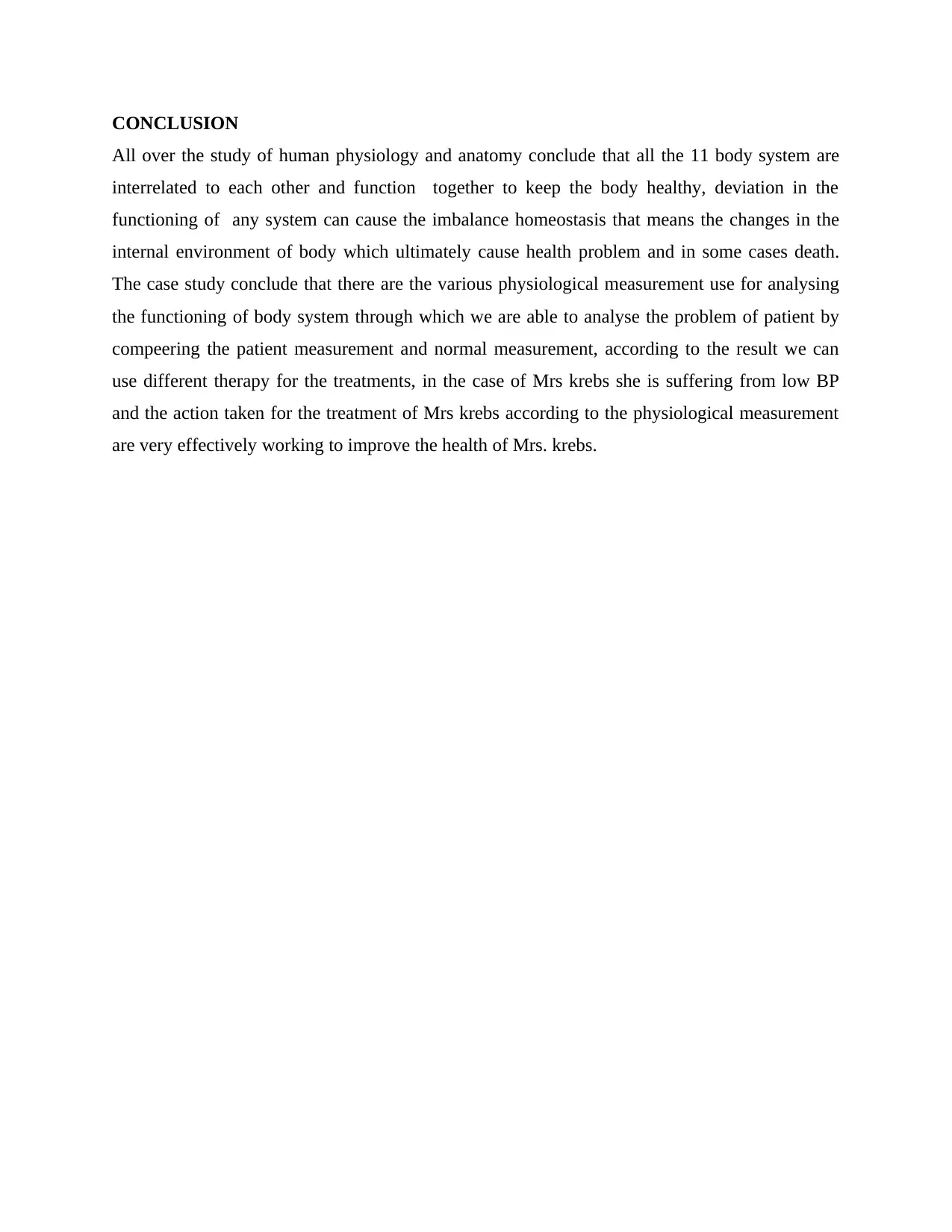
CONCLUSION
All over the study of human physiology and anatomy conclude that all the 11 body system are
interrelated to each other and function together to keep the body healthy, deviation in the
functioning of any system can cause the imbalance homeostasis that means the changes in the
internal environment of body which ultimately cause health problem and in some cases death.
The case study conclude that there are the various physiological measurement use for analysing
the functioning of body system through which we are able to analyse the problem of patient by
compeering the patient measurement and normal measurement, according to the result we can
use different therapy for the treatments, in the case of Mrs krebs she is suffering from low BP
and the action taken for the treatment of Mrs krebs according to the physiological measurement
are very effectively working to improve the health of Mrs. krebs.
All over the study of human physiology and anatomy conclude that all the 11 body system are
interrelated to each other and function together to keep the body healthy, deviation in the
functioning of any system can cause the imbalance homeostasis that means the changes in the
internal environment of body which ultimately cause health problem and in some cases death.
The case study conclude that there are the various physiological measurement use for analysing
the functioning of body system through which we are able to analyse the problem of patient by
compeering the patient measurement and normal measurement, according to the result we can
use different therapy for the treatments, in the case of Mrs krebs she is suffering from low BP
and the action taken for the treatment of Mrs krebs according to the physiological measurement
are very effectively working to improve the health of Mrs. krebs.
Paraphrase This Document
Need a fresh take? Get an instant paraphrase of this document with our AI Paraphraser
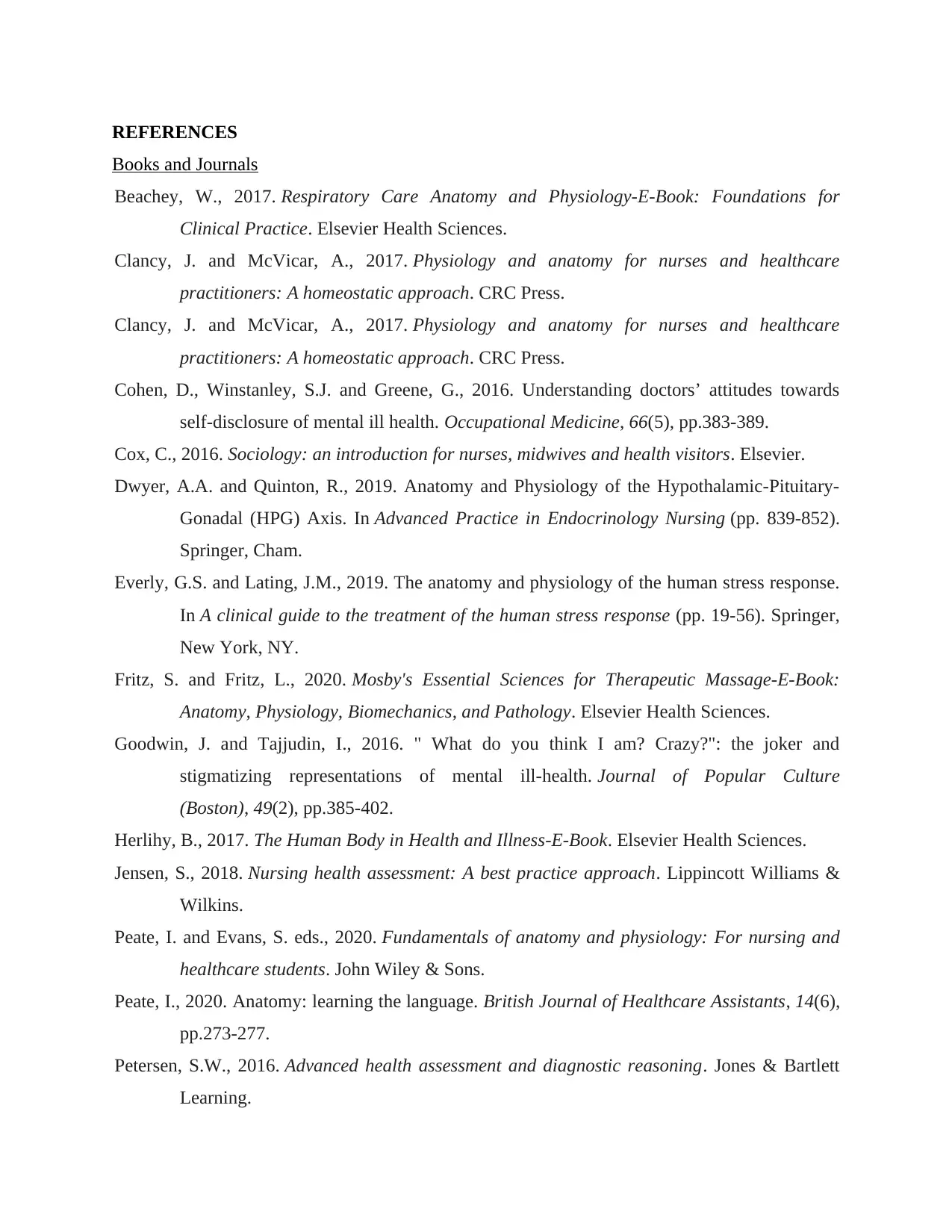
REFERENCES
Books and Journals
Beachey, W., 2017. Respiratory Care Anatomy and Physiology-E-Book: Foundations for
Clinical Practice. Elsevier Health Sciences.
Clancy, J. and McVicar, A., 2017. Physiology and anatomy for nurses and healthcare
practitioners: A homeostatic approach. CRC Press.
Clancy, J. and McVicar, A., 2017. Physiology and anatomy for nurses and healthcare
practitioners: A homeostatic approach. CRC Press.
Cohen, D., Winstanley, S.J. and Greene, G., 2016. Understanding doctors’ attitudes towards
self-disclosure of mental ill health. Occupational Medicine, 66(5), pp.383-389.
Cox, C., 2016. Sociology: an introduction for nurses, midwives and health visitors. Elsevier.
Dwyer, A.A. and Quinton, R., 2019. Anatomy and Physiology of the Hypothalamic-Pituitary-
Gonadal (HPG) Axis. In Advanced Practice in Endocrinology Nursing (pp. 839-852).
Springer, Cham.
Everly, G.S. and Lating, J.M., 2019. The anatomy and physiology of the human stress response.
In A clinical guide to the treatment of the human stress response (pp. 19-56). Springer,
New York, NY.
Fritz, S. and Fritz, L., 2020. Mosby's Essential Sciences for Therapeutic Massage-E-Book:
Anatomy, Physiology, Biomechanics, and Pathology. Elsevier Health Sciences.
Goodwin, J. and Tajjudin, I., 2016. " What do you think I am? Crazy?": the joker and
stigmatizing representations of mental ill-health. Journal of Popular Culture
(Boston), 49(2), pp.385-402.
Herlihy, B., 2017. The Human Body in Health and Illness-E-Book. Elsevier Health Sciences.
Jensen, S., 2018. Nursing health assessment: A best practice approach. Lippincott Williams &
Wilkins.
Peate, I. and Evans, S. eds., 2020. Fundamentals of anatomy and physiology: For nursing and
healthcare students. John Wiley & Sons.
Peate, I., 2020. Anatomy: learning the language. British Journal of Healthcare Assistants, 14(6),
pp.273-277.
Petersen, S.W., 2016. Advanced health assessment and diagnostic reasoning. Jones & Bartlett
Learning.
Books and Journals
Beachey, W., 2017. Respiratory Care Anatomy and Physiology-E-Book: Foundations for
Clinical Practice. Elsevier Health Sciences.
Clancy, J. and McVicar, A., 2017. Physiology and anatomy for nurses and healthcare
practitioners: A homeostatic approach. CRC Press.
Clancy, J. and McVicar, A., 2017. Physiology and anatomy for nurses and healthcare
practitioners: A homeostatic approach. CRC Press.
Cohen, D., Winstanley, S.J. and Greene, G., 2016. Understanding doctors’ attitudes towards
self-disclosure of mental ill health. Occupational Medicine, 66(5), pp.383-389.
Cox, C., 2016. Sociology: an introduction for nurses, midwives and health visitors. Elsevier.
Dwyer, A.A. and Quinton, R., 2019. Anatomy and Physiology of the Hypothalamic-Pituitary-
Gonadal (HPG) Axis. In Advanced Practice in Endocrinology Nursing (pp. 839-852).
Springer, Cham.
Everly, G.S. and Lating, J.M., 2019. The anatomy and physiology of the human stress response.
In A clinical guide to the treatment of the human stress response (pp. 19-56). Springer,
New York, NY.
Fritz, S. and Fritz, L., 2020. Mosby's Essential Sciences for Therapeutic Massage-E-Book:
Anatomy, Physiology, Biomechanics, and Pathology. Elsevier Health Sciences.
Goodwin, J. and Tajjudin, I., 2016. " What do you think I am? Crazy?": the joker and
stigmatizing representations of mental ill-health. Journal of Popular Culture
(Boston), 49(2), pp.385-402.
Herlihy, B., 2017. The Human Body in Health and Illness-E-Book. Elsevier Health Sciences.
Jensen, S., 2018. Nursing health assessment: A best practice approach. Lippincott Williams &
Wilkins.
Peate, I. and Evans, S. eds., 2020. Fundamentals of anatomy and physiology: For nursing and
healthcare students. John Wiley & Sons.
Peate, I., 2020. Anatomy: learning the language. British Journal of Healthcare Assistants, 14(6),
pp.273-277.
Petersen, S.W., 2016. Advanced health assessment and diagnostic reasoning. Jones & Bartlett
Learning.
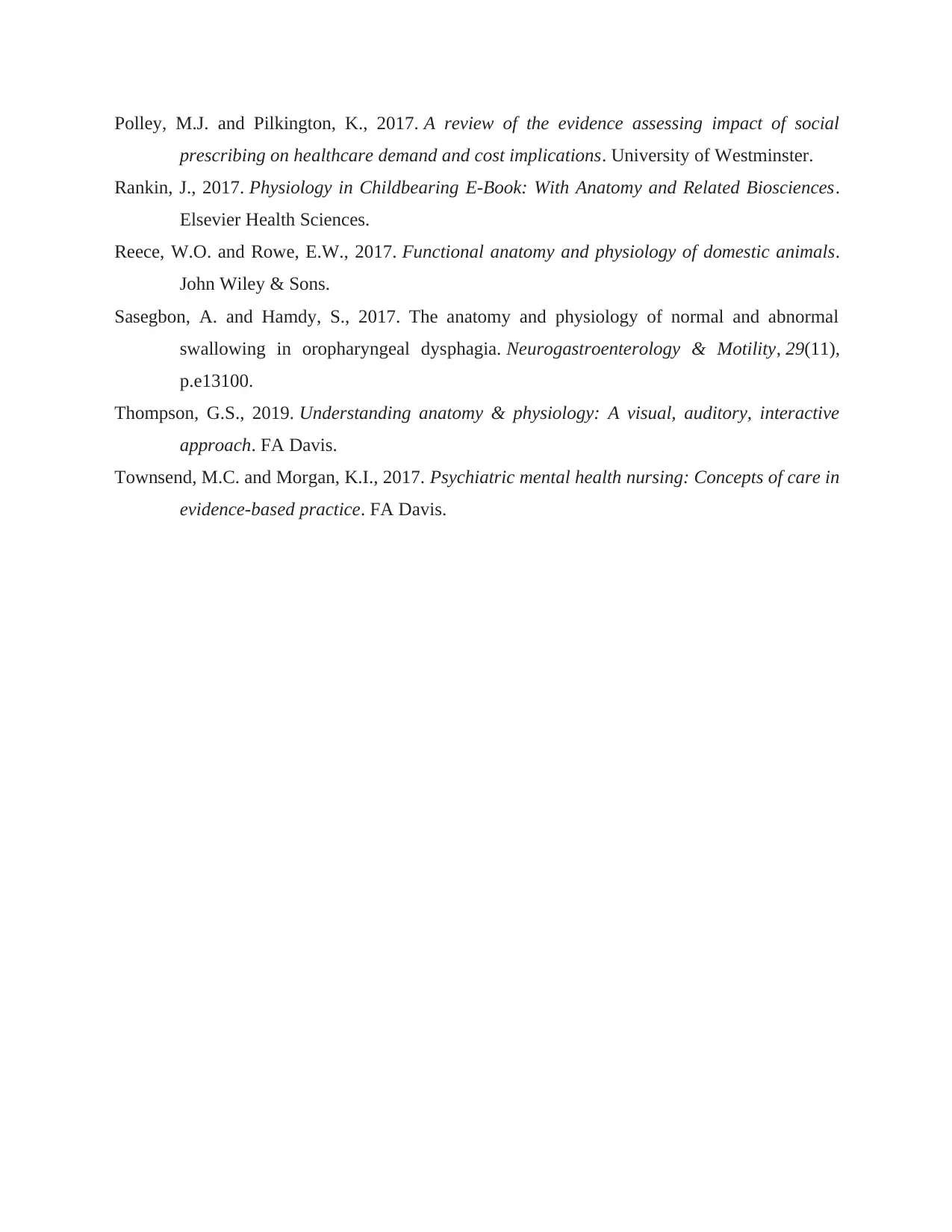
Polley, M.J. and Pilkington, K., 2017. A review of the evidence assessing impact of social
prescribing on healthcare demand and cost implications. University of Westminster.
Rankin, J., 2017. Physiology in Childbearing E-Book: With Anatomy and Related Biosciences.
Elsevier Health Sciences.
Reece, W.O. and Rowe, E.W., 2017. Functional anatomy and physiology of domestic animals.
John Wiley & Sons.
Sasegbon, A. and Hamdy, S., 2017. The anatomy and physiology of normal and abnormal
swallowing in oropharyngeal dysphagia. Neurogastroenterology & Motility, 29(11),
p.e13100.
Thompson, G.S., 2019. Understanding anatomy & physiology: A visual, auditory, interactive
approach. FA Davis.
Townsend, M.C. and Morgan, K.I., 2017. Psychiatric mental health nursing: Concepts of care in
evidence-based practice. FA Davis.
prescribing on healthcare demand and cost implications. University of Westminster.
Rankin, J., 2017. Physiology in Childbearing E-Book: With Anatomy and Related Biosciences.
Elsevier Health Sciences.
Reece, W.O. and Rowe, E.W., 2017. Functional anatomy and physiology of domestic animals.
John Wiley & Sons.
Sasegbon, A. and Hamdy, S., 2017. The anatomy and physiology of normal and abnormal
swallowing in oropharyngeal dysphagia. Neurogastroenterology & Motility, 29(11),
p.e13100.
Thompson, G.S., 2019. Understanding anatomy & physiology: A visual, auditory, interactive
approach. FA Davis.
Townsend, M.C. and Morgan, K.I., 2017. Psychiatric mental health nursing: Concepts of care in
evidence-based practice. FA Davis.
1 out of 39
Related Documents
Your All-in-One AI-Powered Toolkit for Academic Success.
+13062052269
info@desklib.com
Available 24*7 on WhatsApp / Email
![[object Object]](/_next/static/media/star-bottom.7253800d.svg)
Unlock your academic potential
© 2024 | Zucol Services PVT LTD | All rights reserved.





